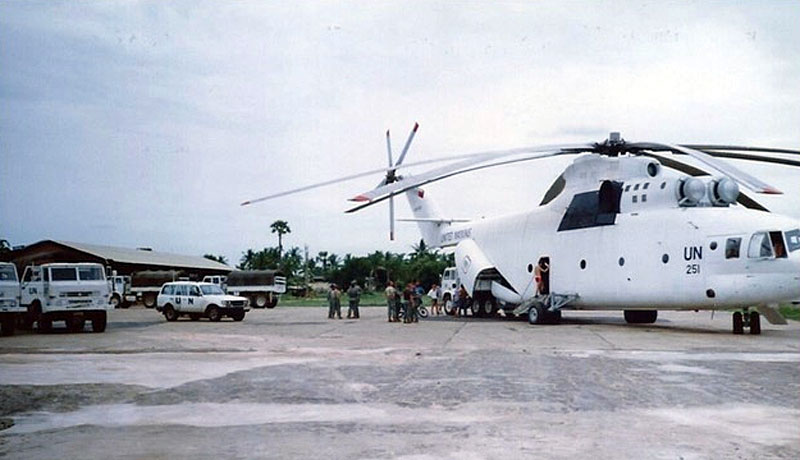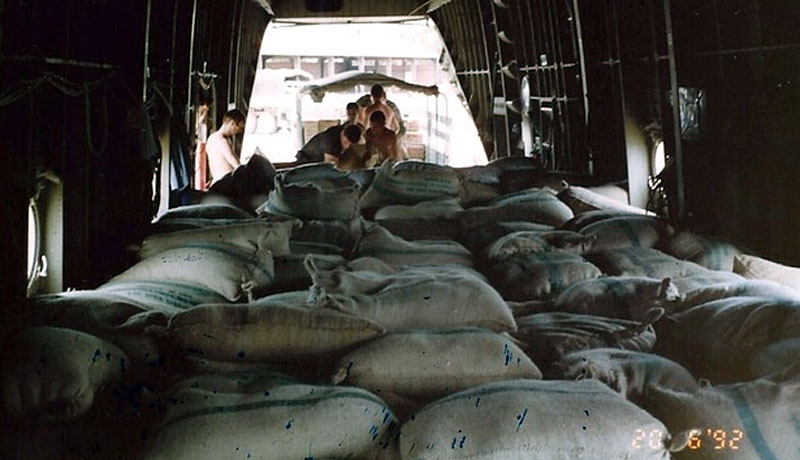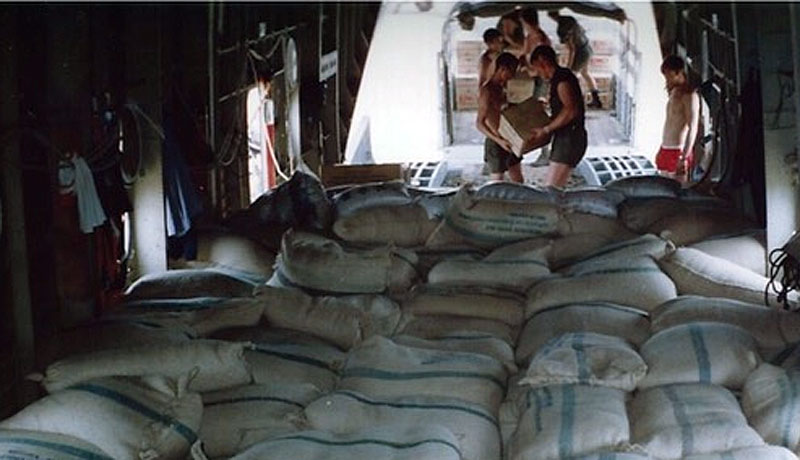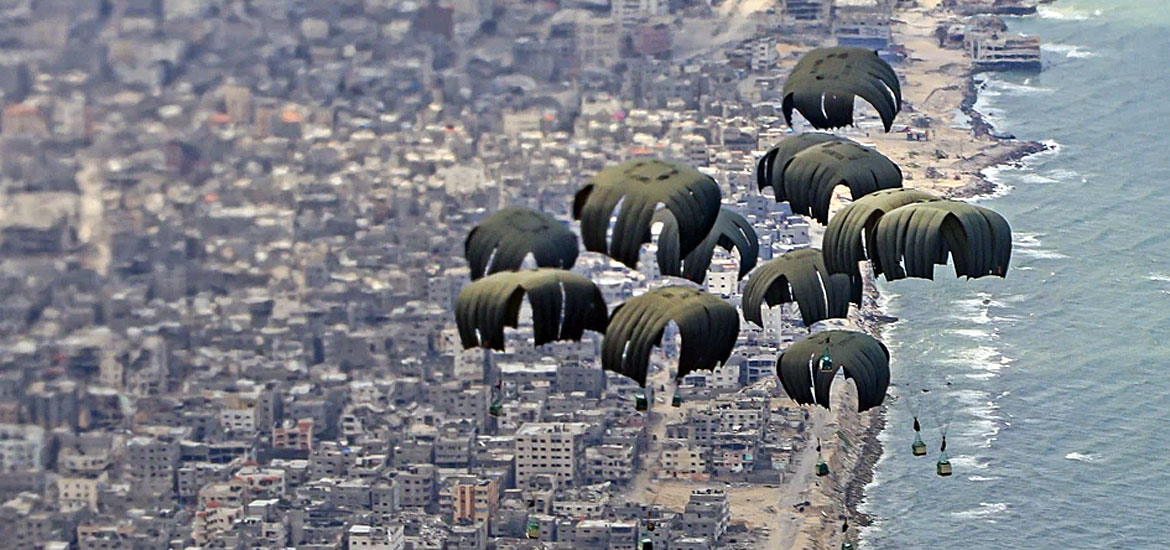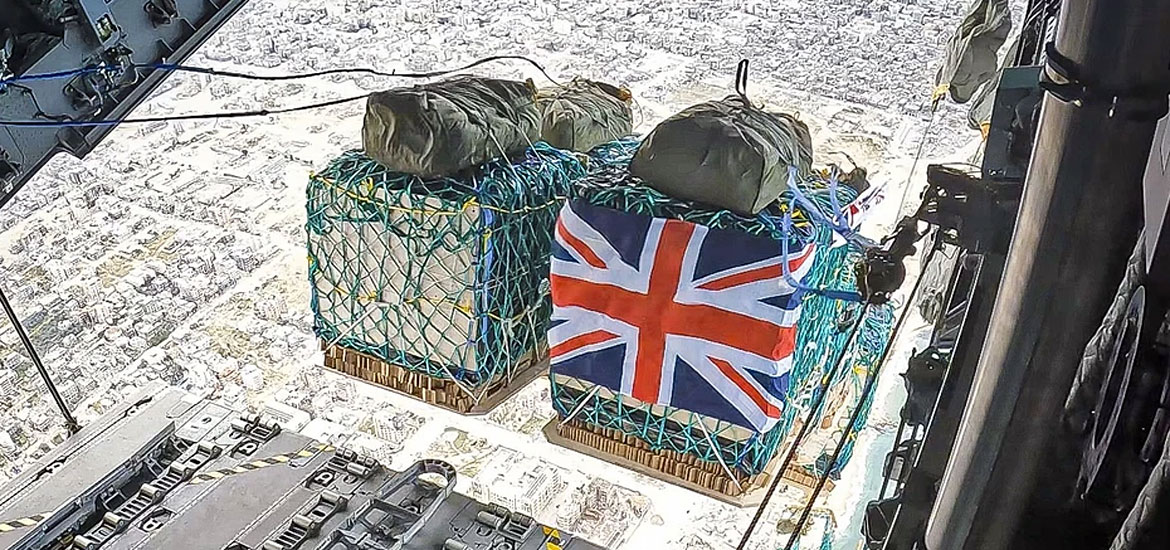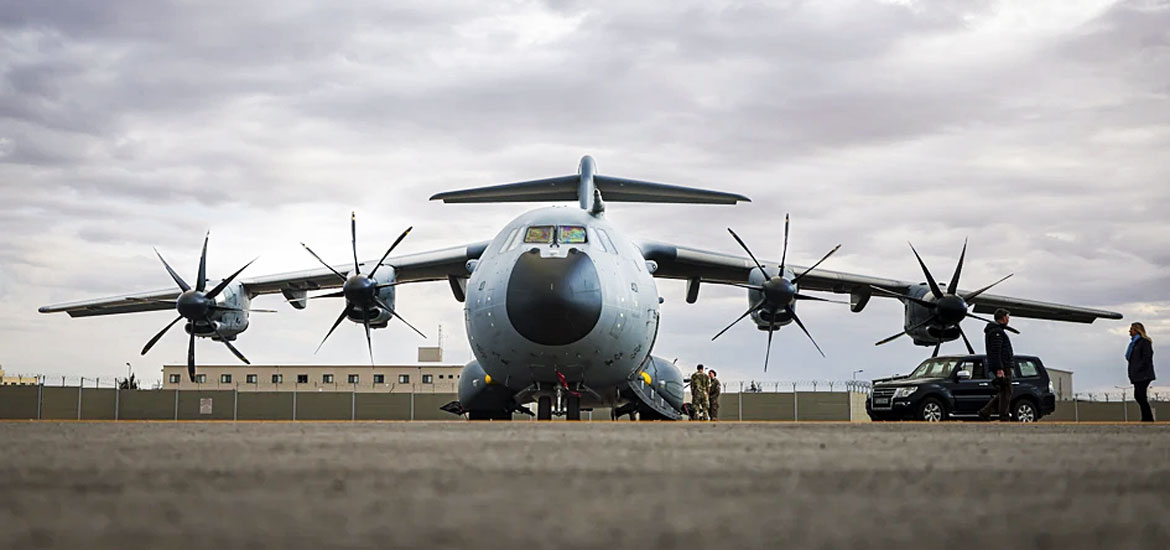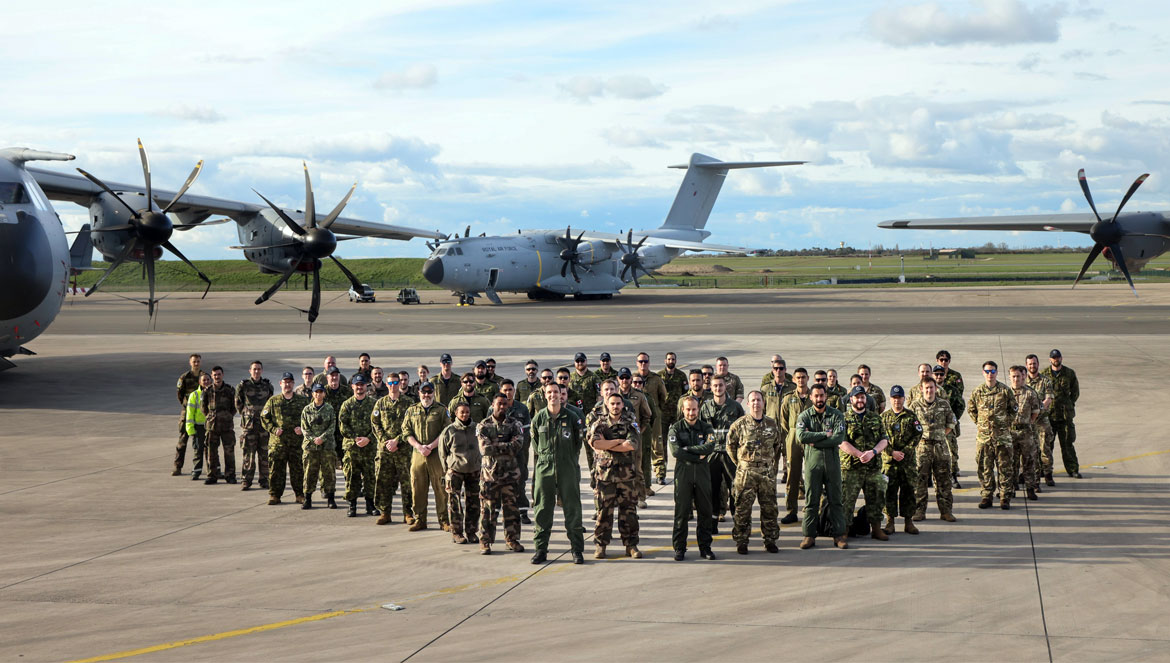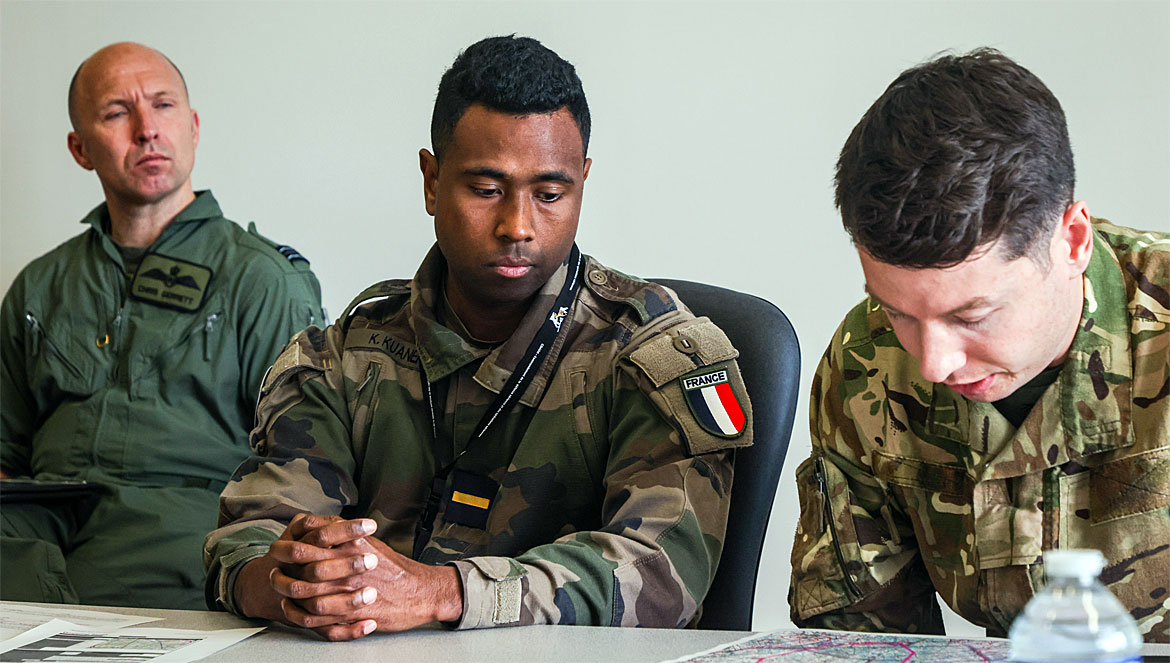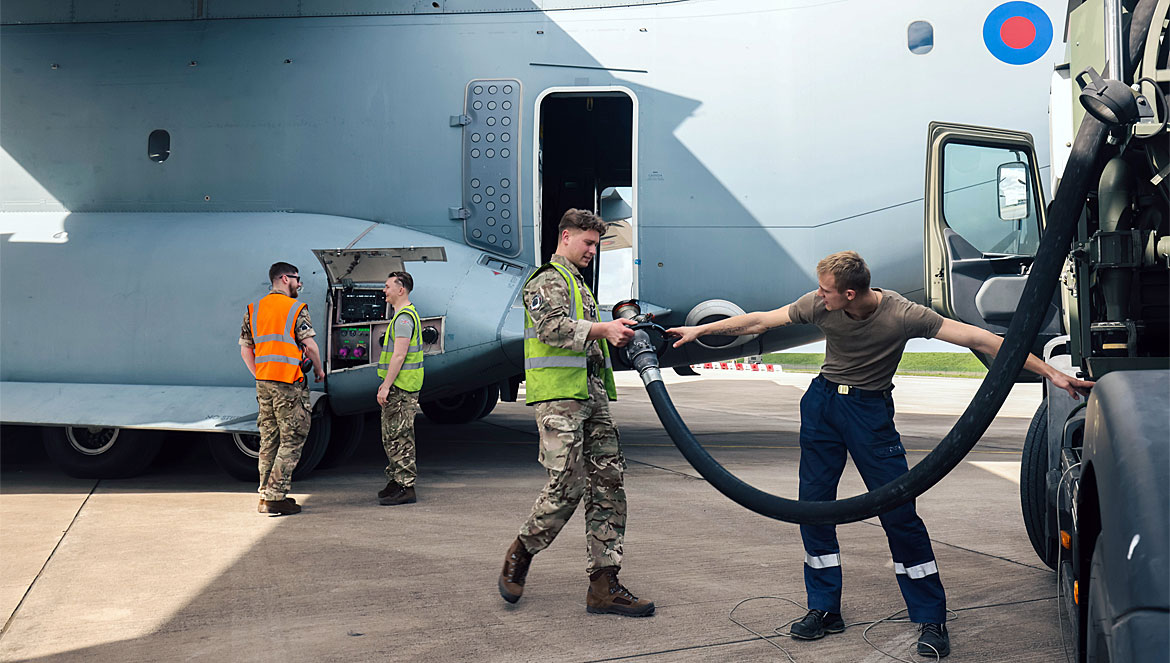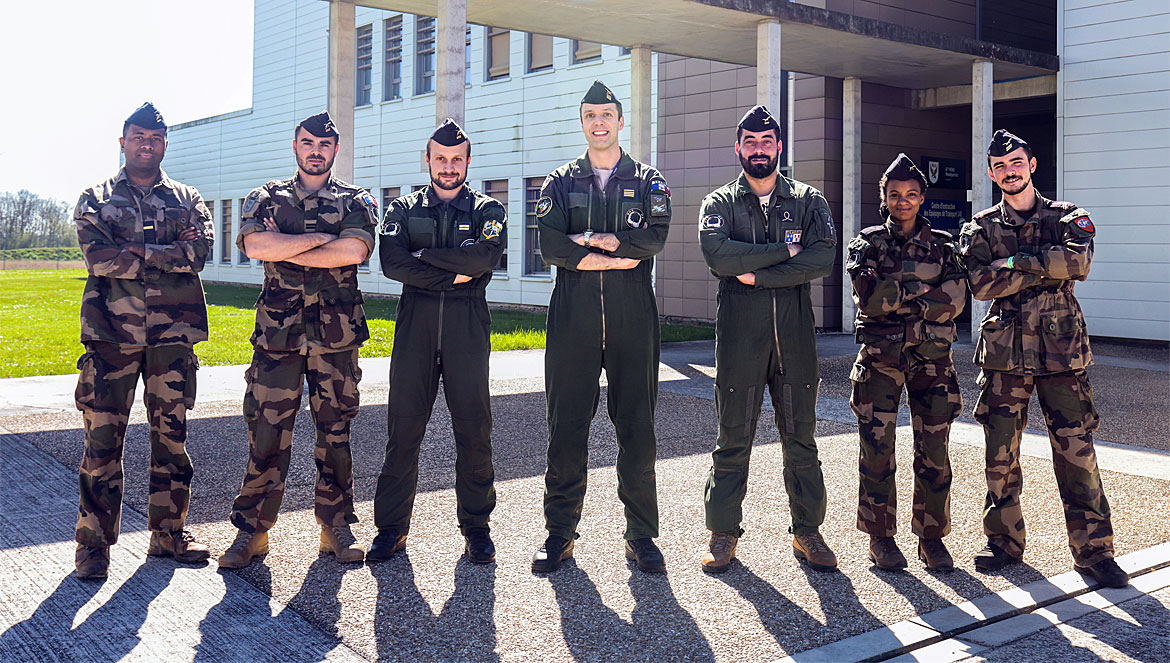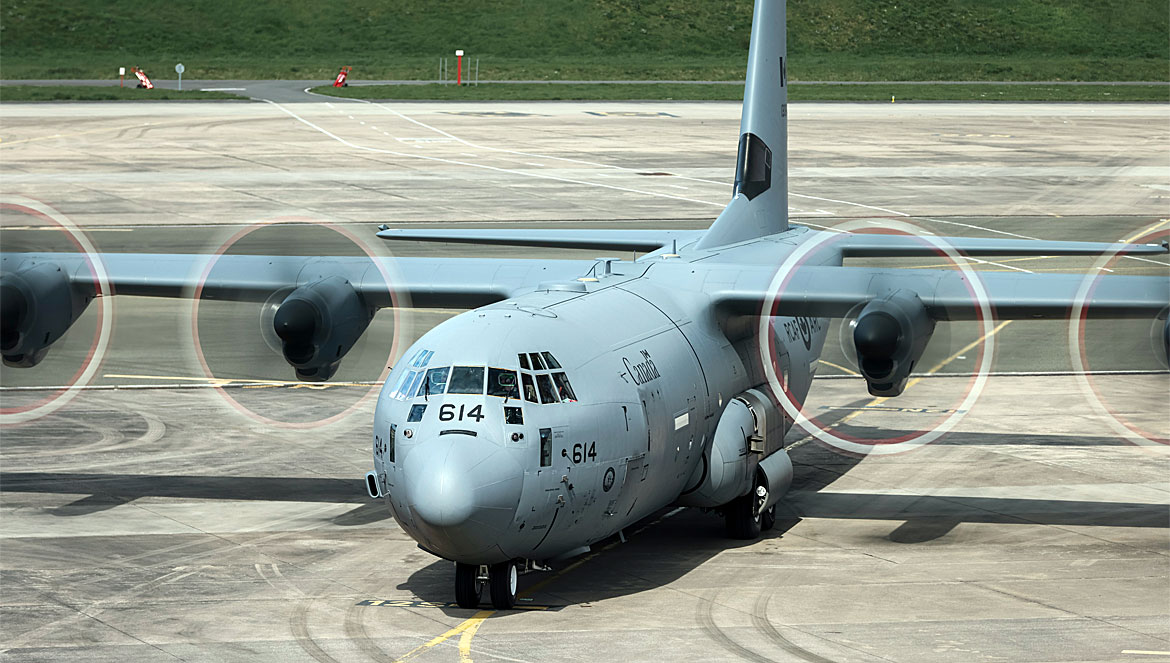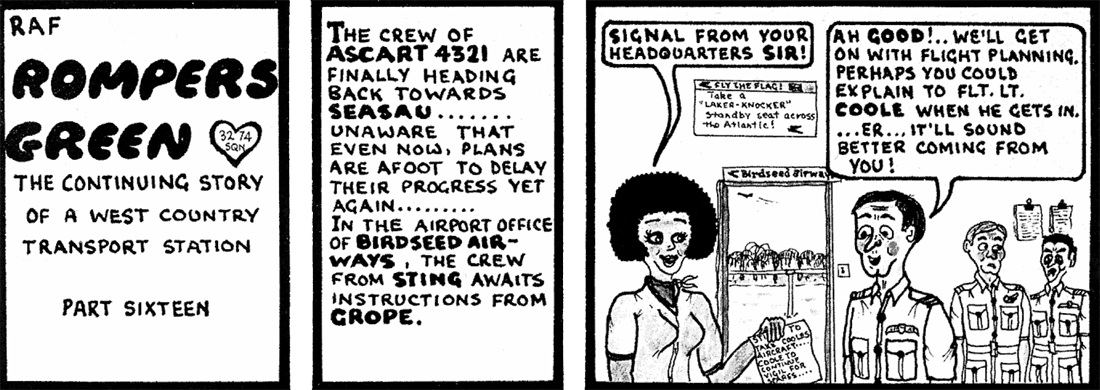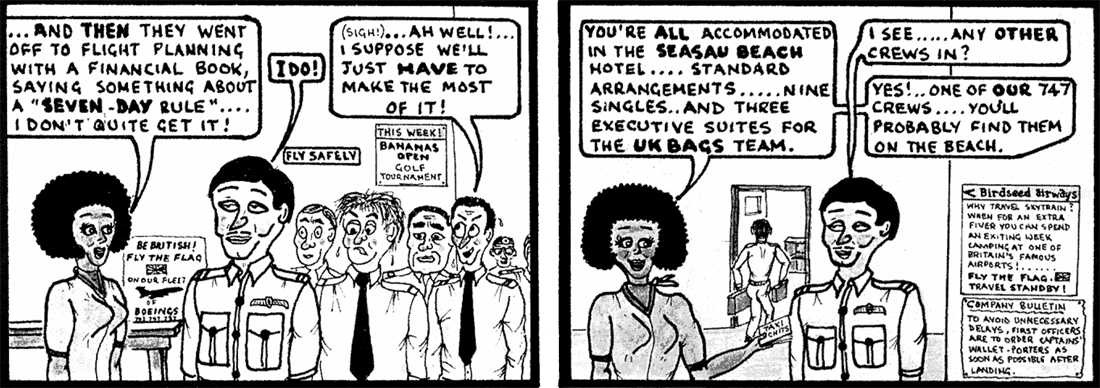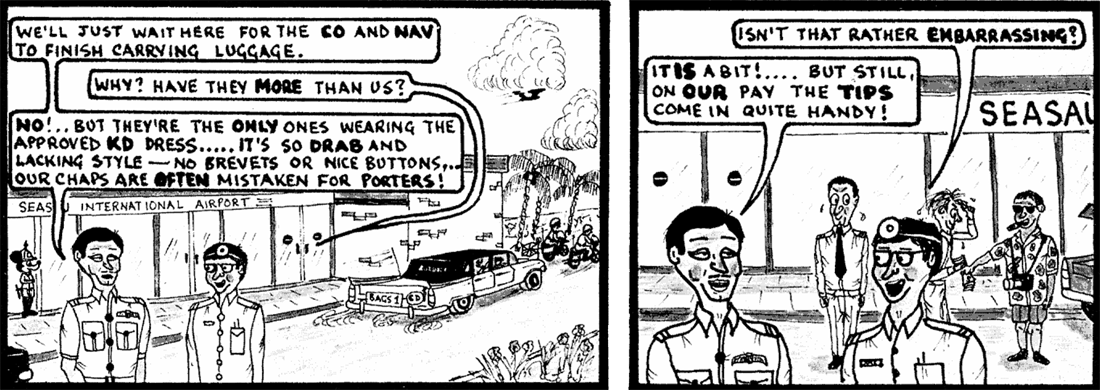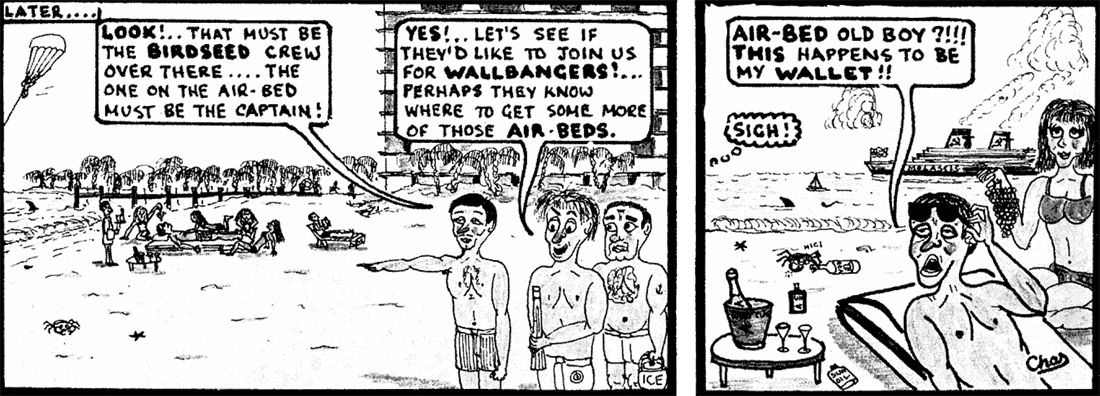



From: Dave Green, Huntingdon, Cambs
Subject: Re: UKMAMS OBA OBB #013124
Hi Tony,
Thanks for yet another great issue; I read 'A Spot of Bother' by Richard King with interest. Whilst I didn't get to the Falklands as I stated before, I was at Brize throughout Op Corporate and I can fill in some of the blanks in Richard's Story.
I was DAMO D shift on the day before Richard's flight departed from Brize and my load control clerk was putting the aircraft paperwork together. It was a busy day (weren't they all during Corporate!) and a Sqn Ldr Engineer arrived from RAF Wittering with a box of Harrier Spares to be taken to Ascension on the next days' flight (Richard's flight). He was the nominated Safe Hand of Escort and my Warrant Officer, Dave Gutsell gave him 2 options regarding the box until the flight was to depart. Option 1 was to be 'Billy No Mates' and drag the large box around wih him to Gateway House, or Option 2 was to deposit the box with the Cargo Section in the Movs hanger until the morning so that the Sqn Ldr could have a more normal evening. He obviously took Option 2 and went to see WO Frank Thorington who was running cargo that day. Frank asked what was in the box when he took it into safe keeping. The reply was 'Missile Spares' so that is what Frank wrote on the side of the box in chalk.
I handed over final prep for the flight that evening to Angie Reid (DAMO B Shift) and went back to the Officers' Mess for dinner. The next morning, my first task at takeover was to accompany Angie out to the departing aircraft to collect the signed Trim Sheet from the aircraft captain as they were nearing departure. We collected the Trim Sheet but the aircraft was on a remote bay (this translates to a bay that is not necessarily flat!) and the cargo door would not lock correctly. I told Angie that I would see the aircraft out and that her shift should go and get breakfast. The ALM tried to close the door freight door several times to no avail, so my traffic team unoffically bumped the door gently with a Condec and it still wouldn't lock. We therefore removed a pallet of medical supplies and the door closed. The aircraft was moved a few feet by an aircraft tug and we reloaded the pallet and the door locked. I didn't see the Sqn Ldr or his box during this time. The aircraft departed a few minutes late and we didn't expect to hear any more about the flight. I finished my last day shift that evening and was due to start my next shift on nights the following evening. Having woken early next morning I went for a motorcycle ride that left me in Wroughton hospital with a broken wrist and a big hole in my knee. Following surgery, I woke up to a BBC news report that the crew of an RAF VC10 had been arrested in Montevideo as the aircraft was flying as a Red Cross aircraft and they had found the 'Missile Spares' box in with the crew bags! It transpires that the Sqn Ldr escorting the box got off at Ascension as planned but didn't take possession of the box and apparently didn't raise any concern until the flight had departed Ascension. I guess that all might have been well if the chalk markings hadn't been applied in the Cargo Hanger or if they had been removed before flight!
The next thing I remember was a Staff Officer arriving at Wroughton who insisted that I accompany him to Upavon for a chat with AVM Hall, AOC 38 Gp, about the ensuing Diplomatic Incident when the box was found. This was a lessons learned interview, luckily and Angie also got to visit the Ivory Tower for a similar chat. I did read somewhere a few years back the the Sqn Ldr was Court Marshalled and thrown out of the RAF for his actions. It just goes to show that a series of what would normally be inconsequential actions can have a very serious effect. I believe that the 'Missile Spares' were the arming lanyards to allow the Harrier to fire Shrike missiles at Argentinian radar sites hence the massive importance of the box reaching its destination on time.
Rgds
Dave Green
Subject: Re: UKMAMS OBA OBB #013124
Hi Tony,
Thanks for yet another great issue; I read 'A Spot of Bother' by Richard King with interest. Whilst I didn't get to the Falklands as I stated before, I was at Brize throughout Op Corporate and I can fill in some of the blanks in Richard's Story.
I was DAMO D shift on the day before Richard's flight departed from Brize and my load control clerk was putting the aircraft paperwork together. It was a busy day (weren't they all during Corporate!) and a Sqn Ldr Engineer arrived from RAF Wittering with a box of Harrier Spares to be taken to Ascension on the next days' flight (Richard's flight). He was the nominated Safe Hand of Escort and my Warrant Officer, Dave Gutsell gave him 2 options regarding the box until the flight was to depart. Option 1 was to be 'Billy No Mates' and drag the large box around wih him to Gateway House, or Option 2 was to deposit the box with the Cargo Section in the Movs hanger until the morning so that the Sqn Ldr could have a more normal evening. He obviously took Option 2 and went to see WO Frank Thorington who was running cargo that day. Frank asked what was in the box when he took it into safe keeping. The reply was 'Missile Spares' so that is what Frank wrote on the side of the box in chalk.
I handed over final prep for the flight that evening to Angie Reid (DAMO B Shift) and went back to the Officers' Mess for dinner. The next morning, my first task at takeover was to accompany Angie out to the departing aircraft to collect the signed Trim Sheet from the aircraft captain as they were nearing departure. We collected the Trim Sheet but the aircraft was on a remote bay (this translates to a bay that is not necessarily flat!) and the cargo door would not lock correctly. I told Angie that I would see the aircraft out and that her shift should go and get breakfast. The ALM tried to close the door freight door several times to no avail, so my traffic team unoffically bumped the door gently with a Condec and it still wouldn't lock. We therefore removed a pallet of medical supplies and the door closed. The aircraft was moved a few feet by an aircraft tug and we reloaded the pallet and the door locked. I didn't see the Sqn Ldr or his box during this time. The aircraft departed a few minutes late and we didn't expect to hear any more about the flight. I finished my last day shift that evening and was due to start my next shift on nights the following evening. Having woken early next morning I went for a motorcycle ride that left me in Wroughton hospital with a broken wrist and a big hole in my knee. Following surgery, I woke up to a BBC news report that the crew of an RAF VC10 had been arrested in Montevideo as the aircraft was flying as a Red Cross aircraft and they had found the 'Missile Spares' box in with the crew bags! It transpires that the Sqn Ldr escorting the box got off at Ascension as planned but didn't take possession of the box and apparently didn't raise any concern until the flight had departed Ascension. I guess that all might have been well if the chalk markings hadn't been applied in the Cargo Hanger or if they had been removed before flight!
The next thing I remember was a Staff Officer arriving at Wroughton who insisted that I accompany him to Upavon for a chat with AVM Hall, AOC 38 Gp, about the ensuing Diplomatic Incident when the box was found. This was a lessons learned interview, luckily and Angie also got to visit the Ivory Tower for a similar chat. I did read somewhere a few years back the the Sqn Ldr was Court Marshalled and thrown out of the RAF for his actions. It just goes to show that a series of what would normally be inconsequential actions can have a very serious effect. I believe that the 'Missile Spares' were the arming lanyards to allow the Harrier to fire Shrike missiles at Argentinian radar sites hence the massive importance of the box reaching its destination on time.
Rgds
Dave Green


From: John Leek, La Ronde
Subject: Flat Floor Loads
Hi Tony,
In 1965, a French Air Force Breguet Sahara lobbed into Northolt loaded with wreckage from a Constellation that had crashed in West Africa. The wreckage was destined for Farnborough; why it arrived at Northolt was not known.
The load was simply roped to the floors and was jumbled into two continuous lumps. Sharp edges everywhere plus quantities of sand, spiders, scorpions and at least one live snake. All offloaded using forklift and pallets. We went through several pairs of gloves plus ripped overalls getting the load off and then, several days later, put the lot (plus the snake) onto 2 Queen Mary transport lorries.
John
Subject: Flat Floor Loads
Hi Tony,
In 1965, a French Air Force Breguet Sahara lobbed into Northolt loaded with wreckage from a Constellation that had crashed in West Africa. The wreckage was destined for Farnborough; why it arrived at Northolt was not known.
The load was simply roped to the floors and was jumbled into two continuous lumps. Sharp edges everywhere plus quantities of sand, spiders, scorpions and at least one live snake. All offloaded using forklift and pallets. We went through several pairs of gloves plus ripped overalls getting the load off and then, several days later, put the lot (plus the snake) onto 2 Queen Mary transport lorries.
John

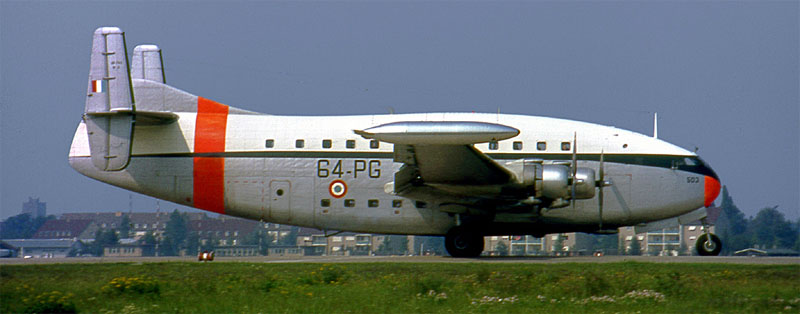
French Air Force Breguet Sahara

From: Bob Pountney, Forres, Moray
Subject: Flat Floor Loads
Hi Tony,
Hope this finds you well. I've included a piece which is from a book I'm attempting to write and it's from the one year stint I did in Masirah. Although not Movements qualified I talked the SEO into giving me a job as Cpl i/c Passengers but, as we were a very small section I used to help out on the aircraft which later came in handy on my AQM course.
"Later in my time on Air Movements at Masirah, I was doing a stint as Team Leader when a Beverley came in carrying a radio cabin which was a very large, heavy box that took up about a quarter of the hold. It was an important part of an exercise due to start in a couple of days and had to be off-loaded. The only problem was the transit wheels which plugged into the sides of the cabin had been left behind and the cabin was flush on the aircraft floor, even worse, it was right at the front of the hold. It has to come off, ordered the AQM and I don’t care how you do it. Paddy was away on leave so the task fell to me.
My method was to have a flat bed trailer backed up on chocks so it was the same height as the Beverley sill, reverse the Bedford 3 ton lorry up to the trailer and connect 10,000lb chains to the cabin and the tow hook on the Bedford. Right Ahmed, I said to the Bedford driver, when I say go put your foot down and keep going until I shout stop. This he did and the container came out of the aircraft hold at a great rate of knots and landed with a very large bang on the trailer. Job done thought I until a very angry AQM bollocked me for ripping up part of the aircraft floor. “You said it had to come off” was my reply and there it was sat on the trailer. Luckily this aircraft was on its last trip before returning to the UK for scrapping."
Kind regards,
Bob
Subject: Flat Floor Loads
Hi Tony,
Hope this finds you well. I've included a piece which is from a book I'm attempting to write and it's from the one year stint I did in Masirah. Although not Movements qualified I talked the SEO into giving me a job as Cpl i/c Passengers but, as we were a very small section I used to help out on the aircraft which later came in handy on my AQM course.
"Later in my time on Air Movements at Masirah, I was doing a stint as Team Leader when a Beverley came in carrying a radio cabin which was a very large, heavy box that took up about a quarter of the hold. It was an important part of an exercise due to start in a couple of days and had to be off-loaded. The only problem was the transit wheels which plugged into the sides of the cabin had been left behind and the cabin was flush on the aircraft floor, even worse, it was right at the front of the hold. It has to come off, ordered the AQM and I don’t care how you do it. Paddy was away on leave so the task fell to me.
My method was to have a flat bed trailer backed up on chocks so it was the same height as the Beverley sill, reverse the Bedford 3 ton lorry up to the trailer and connect 10,000lb chains to the cabin and the tow hook on the Bedford. Right Ahmed, I said to the Bedford driver, when I say go put your foot down and keep going until I shout stop. This he did and the container came out of the aircraft hold at a great rate of knots and landed with a very large bang on the trailer. Job done thought I until a very angry AQM bollocked me for ripping up part of the aircraft floor. “You said it had to come off” was my reply and there it was sat on the trailer. Luckily this aircraft was on its last trip before returning to the UK for scrapping."
Kind regards,
Bob


UK buys 14 Chinook Extended Range Helicopters from US
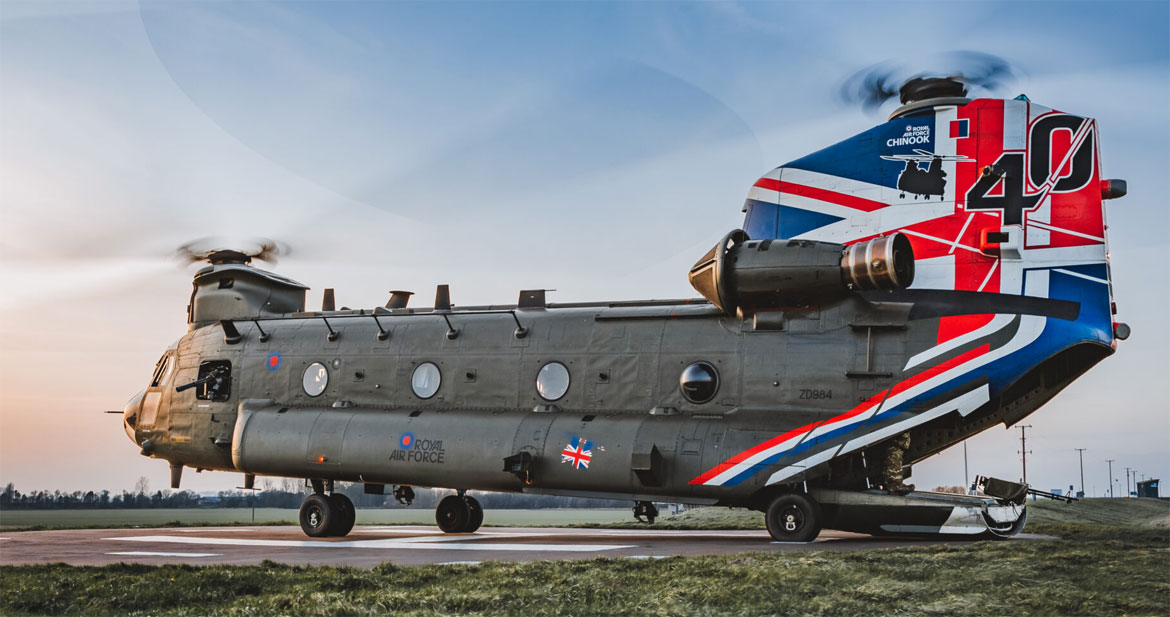
The British government has signed a contract to procure 14 CH-47F Chinook extended-range military helicopters from the US.
The acquisition is part of the UK’s ongoing efforts to expand its heavy-lift capability and sustain operability in “challenging environments” such as deserts and the Arctic. In addition to doubling the armed forces’ range in rotorcraft-based missions, the upcoming fleet will integrate air-to-air refueling functionality, upgraded airframes, and advanced digital cockpits to boost the “stability and survivability” of warfighters.
Each of the aircraft will have a maximum speed of 300 kilometers (190 miles) per hour and capacity for either 55 troops or up to 10,000 kilograms (22,000 pounds) of payload.
According to the British defense agency, negotiations between the UK military procurement arm Defence Equipment & Support (DE&S) and the US government have reduced the procurement’s cost by over 300 million pounds ($382 million). Furthermore, the foreign military sale will see local British companies produce critical elements related to the manufacturing and maintenance of the future Chinooks. This approach is expected to enhance the domestic industry by creating jobs in aircraft avionics and electric power areas while providing approximately 151 million pounds ($192 million) into the economy.
“Procuring these Chinook helicopters will mark a significant milestone in our efforts to modernise and enhance the agility of the UK Armed Forces, cementing our ability to respond at pace to situations and threats across the globe,” UK Defence Secretary Grant Shapps stated. “The Chinook is one of our most iconic aircraft, having been operated in every major conflict since the Falklands War. Delivering on this deal not only enhances our capability, but will boost UK industry and skills.”
The UK is one of the longest CH-47 users aside from the US Army. The helicopter was first introduced to the British military service in the 1980s as a replacement for the Belvedere and Wessex helicopters.
thedefensepost.com
The acquisition is part of the UK’s ongoing efforts to expand its heavy-lift capability and sustain operability in “challenging environments” such as deserts and the Arctic. In addition to doubling the armed forces’ range in rotorcraft-based missions, the upcoming fleet will integrate air-to-air refueling functionality, upgraded airframes, and advanced digital cockpits to boost the “stability and survivability” of warfighters.
Each of the aircraft will have a maximum speed of 300 kilometers (190 miles) per hour and capacity for either 55 troops or up to 10,000 kilograms (22,000 pounds) of payload.
According to the British defense agency, negotiations between the UK military procurement arm Defence Equipment & Support (DE&S) and the US government have reduced the procurement’s cost by over 300 million pounds ($382 million). Furthermore, the foreign military sale will see local British companies produce critical elements related to the manufacturing and maintenance of the future Chinooks. This approach is expected to enhance the domestic industry by creating jobs in aircraft avionics and electric power areas while providing approximately 151 million pounds ($192 million) into the economy.
“Procuring these Chinook helicopters will mark a significant milestone in our efforts to modernise and enhance the agility of the UK Armed Forces, cementing our ability to respond at pace to situations and threats across the globe,” UK Defence Secretary Grant Shapps stated. “The Chinook is one of our most iconic aircraft, having been operated in every major conflict since the Falklands War. Delivering on this deal not only enhances our capability, but will boost UK industry and skills.”
The UK is one of the longest CH-47 users aside from the US Army. The helicopter was first introduced to the British military service in the 1980s as a replacement for the Belvedere and Wessex helicopters.
thedefensepost.com

From: Fred Hebb, Gold River, NS
Subject: Flat Floor Loads
Hi Tony,
I remember when most of our loads were flat floor, the most memorable one for me was on a C130B when I was in Namao in 1961; it was a load of boxes of publications from RCAF Station Rockcliffe in Ottawa. I remember bending over and man-handling each of those boxes until they were offloaded. And they wonder why our trade group experiences bad backs?
There many other loads on C119’s, North Stars and C130’s. We thought we had gone to heaven when the loads were on skate wheel rollers. I had a load out of Alert one time on skate wheels, it was a CAT generator that weighed over 30k pounds and the radiator was on the ramp, one hour turn around, which ended up to be one and a half. The only loading aid was a four-thousand lb winch and an old Army three-quarter ton to push the pallet.
When we got back to Uplands I got crap for late turnaround offloading, loading, tie down, etc. I will always remember that lovely Aircraft Commander on that flight. That one hour turn around was one hour and a half which was supposed to include my lunch which ended up being a box lunch.
That was one of those lucky days when we did SF 85/86 by yourself. Thanks AC or maybe AH.
Fred
Subject: Flat Floor Loads
Hi Tony,
I remember when most of our loads were flat floor, the most memorable one for me was on a C130B when I was in Namao in 1961; it was a load of boxes of publications from RCAF Station Rockcliffe in Ottawa. I remember bending over and man-handling each of those boxes until they were offloaded. And they wonder why our trade group experiences bad backs?
There many other loads on C119’s, North Stars and C130’s. We thought we had gone to heaven when the loads were on skate wheel rollers. I had a load out of Alert one time on skate wheels, it was a CAT generator that weighed over 30k pounds and the radiator was on the ramp, one hour turn around, which ended up to be one and a half. The only loading aid was a four-thousand lb winch and an old Army three-quarter ton to push the pallet.
When we got back to Uplands I got crap for late turnaround offloading, loading, tie down, etc. I will always remember that lovely Aircraft Commander on that flight. That one hour turn around was one hour and a half which was supposed to include my lunch which ended up being a box lunch.
That was one of those lucky days when we did SF 85/86 by yourself. Thanks AC or maybe AH.
Fred


From: Pete Orton, Camberley, Surrey
Subject: Flat Floor Loads
Once again Tony you have kicked a dormant brain cell out of retirement!
Those of us of the 60’s generation of "humpers and dumpers" were not enamoured with the progress of ACHE and unit load devices of that era. Pallet building was laborious, and the side guidance for the Beverley was payload eliminating ballast. The Britannia Freight Lift Platform (BFLP) and Trianco Transfer Loaders were a rigging nightmare. Reflecting on modern systems, we were positively Flintstone in pre "Elf n safe tea".
I cut my teeth on Blackburn's steam driven Beverely and the opportunity to spend all night perspiring in the Bahrain sauna loading the AFME 8 with at least 3 frame changes over the 3-day shift cycle.
Fast forward 7 years, Hercs and user-friendly loading systems, Kingsfield Cyprus. a little tactical operation, involving offloading UK based Hercs reloading on to NEAF Hercs for a 10/15 minute hop from West to East SBA [This happened during the Turkish invasion of Cyprus in 1974.] One of several confusions was determining who needed a load of tentage and barbed wire.
We saw the same load shuttle between us and Akrotiri so many times it got nicknamed "Kissinger's cabin baggage".
Bales of barbed wire and "girt 'eavy" sacks of canvas are not the kindest things to handle, but with several practices we got the hang of it, I can't remember who ended up with it, it was an epic game of pass the parcel.
Thanks, Tony, for reminding me of my youthful fun in the sun. Automated in plane loading, rigid ULDs and DCS systems seems to be a different world to this Luddite. Nostalgia!
Pete.
Subject: Flat Floor Loads
Once again Tony you have kicked a dormant brain cell out of retirement!
Those of us of the 60’s generation of "humpers and dumpers" were not enamoured with the progress of ACHE and unit load devices of that era. Pallet building was laborious, and the side guidance for the Beverley was payload eliminating ballast. The Britannia Freight Lift Platform (BFLP) and Trianco Transfer Loaders were a rigging nightmare. Reflecting on modern systems, we were positively Flintstone in pre "Elf n safe tea".
I cut my teeth on Blackburn's steam driven Beverely and the opportunity to spend all night perspiring in the Bahrain sauna loading the AFME 8 with at least 3 frame changes over the 3-day shift cycle.
Fast forward 7 years, Hercs and user-friendly loading systems, Kingsfield Cyprus. a little tactical operation, involving offloading UK based Hercs reloading on to NEAF Hercs for a 10/15 minute hop from West to East SBA [This happened during the Turkish invasion of Cyprus in 1974.] One of several confusions was determining who needed a load of tentage and barbed wire.
We saw the same load shuttle between us and Akrotiri so many times it got nicknamed "Kissinger's cabin baggage".
Bales of barbed wire and "girt 'eavy" sacks of canvas are not the kindest things to handle, but with several practices we got the hang of it, I can't remember who ended up with it, it was an epic game of pass the parcel.
Thanks, Tony, for reminding me of my youthful fun in the sun. Automated in plane loading, rigid ULDs and DCS systems seems to be a different world to this Luddite. Nostalgia!
Pete.
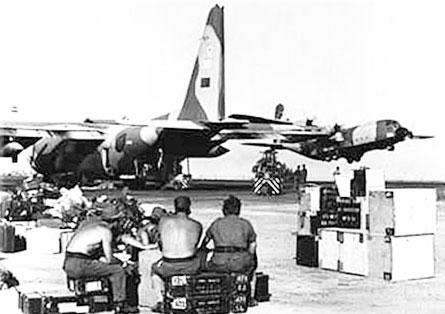
A 70 Squadron Hercules takes off from Kingsfield


From: Aaron Reynolds, Townsville, QLD
Subject: Flat floor loads in Papua New Guinea
Good morning Tony,
In early 1993 I was posted to Mobile Air Terminal Unit 1 (MATU1) and tasked to support a 37SQN Papua New Guinea (PNG) C-130E Trainer for a week flying odd loads around PNG. I grabbed LAC Mick ‘Ox’ Oxenham from MATU2 out of AMB with me as a partner in loading. This task had us flying into amazing places like Rabaul, Madang and Port Moresby, always flat floor loads but usually a vehicle, aid stores or PNG Defence Force members and bags.
One of the load legs consisted of moving a rather shoddy ‘Baileys’ bridge from Vanimo to Green River. Ox and I (with the assistance of some locals, I got rather good at speaking Tok Pisin by the end of this trip that led to a 3 year posting many years later) had weighed, prepared and load-planned the bridge. We still had to try and work out how to secure numerous lengths of railway track that formed the backbone of the bridge. The basic idea we came up with was to thread 10k chains through holes pre-drilled in the tracks to provide some restraint and use heavy shoring as fore and aft walls (suitably restrained of course). We then went for a refreshing swim in the ocean awaiting the return of the Herc from its first leg to Green River with other cargo.
The Loady, Ian Macguire, was happy with our plan and we started to load by hand (none of those MHE forklift things in PNG), everything went swimmingly, even the crap job of threading the chain went better than expected and the majority of the load was restrained and good to go, just some rather heavy metal bolt plates to load on the ramp left. This is where we missed one vital loading issue, the tarmac was sloped toward the ocean and the Herc was parked pointing away from the water... An hour or so later, Ian, Ox and I had finished loading and securing the plates to the ramp and were about to close up and put the aircraft to bed for the night.
Pumping away on the hydraulic handle and be buggered if the ramp would not lift off the ramp jack… WTF we thought? We recycled the rotary selector and tried again… no movement, it was about that time I jumped out of the Herc to look at the ramp to see if there was an external problem I’d missed… The 2’ drop from the bottom stair of the crew entrance door told me all I needed to know…. the nose wheel was a couple of feet off the deck and the Herc was squatting on the ramp jack!
Rapid pumping of the jack handle to put the ramp back down until the nose gear re-engaged mother earth was done and we rapidly kicked all the bolt plates off the ramp before closing up and going for a well-deserved beer (which may or may not have involved tossing empty beer cans into the co-pilots ceiling fan… my memory is hazy of that night).
Lesson learnt about a sloping parking bay and a good laugh years later. Flat floor loads were always fun, I could tell a belter about offloading flexible fuel bladders at a dirt strip in high range above Townsville or another in Irian Jaya…
Cheers!
WOFF Aaron Reynolds (M5)
Subject: Flat floor loads in Papua New Guinea
Good morning Tony,
In early 1993 I was posted to Mobile Air Terminal Unit 1 (MATU1) and tasked to support a 37SQN Papua New Guinea (PNG) C-130E Trainer for a week flying odd loads around PNG. I grabbed LAC Mick ‘Ox’ Oxenham from MATU2 out of AMB with me as a partner in loading. This task had us flying into amazing places like Rabaul, Madang and Port Moresby, always flat floor loads but usually a vehicle, aid stores or PNG Defence Force members and bags.
One of the load legs consisted of moving a rather shoddy ‘Baileys’ bridge from Vanimo to Green River. Ox and I (with the assistance of some locals, I got rather good at speaking Tok Pisin by the end of this trip that led to a 3 year posting many years later) had weighed, prepared and load-planned the bridge. We still had to try and work out how to secure numerous lengths of railway track that formed the backbone of the bridge. The basic idea we came up with was to thread 10k chains through holes pre-drilled in the tracks to provide some restraint and use heavy shoring as fore and aft walls (suitably restrained of course). We then went for a refreshing swim in the ocean awaiting the return of the Herc from its first leg to Green River with other cargo.
The Loady, Ian Macguire, was happy with our plan and we started to load by hand (none of those MHE forklift things in PNG), everything went swimmingly, even the crap job of threading the chain went better than expected and the majority of the load was restrained and good to go, just some rather heavy metal bolt plates to load on the ramp left. This is where we missed one vital loading issue, the tarmac was sloped toward the ocean and the Herc was parked pointing away from the water... An hour or so later, Ian, Ox and I had finished loading and securing the plates to the ramp and were about to close up and put the aircraft to bed for the night.
Pumping away on the hydraulic handle and be buggered if the ramp would not lift off the ramp jack… WTF we thought? We recycled the rotary selector and tried again… no movement, it was about that time I jumped out of the Herc to look at the ramp to see if there was an external problem I’d missed… The 2’ drop from the bottom stair of the crew entrance door told me all I needed to know…. the nose wheel was a couple of feet off the deck and the Herc was squatting on the ramp jack!
Rapid pumping of the jack handle to put the ramp back down until the nose gear re-engaged mother earth was done and we rapidly kicked all the bolt plates off the ramp before closing up and going for a well-deserved beer (which may or may not have involved tossing empty beer cans into the co-pilots ceiling fan… my memory is hazy of that night).
Lesson learnt about a sloping parking bay and a good laugh years later. Flat floor loads were always fun, I could tell a belter about offloading flexible fuel bladders at a dirt strip in high range above Townsville or another in Irian Jaya…
Cheers!
WOFF Aaron Reynolds (M5)
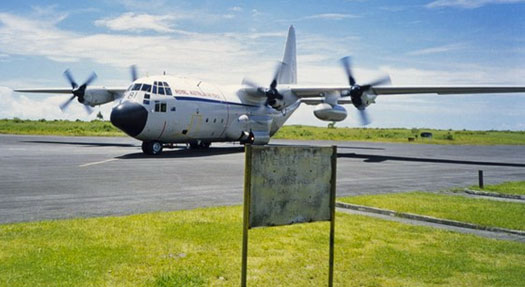


For sale, as is where is: RNZAF's old Hercules planes
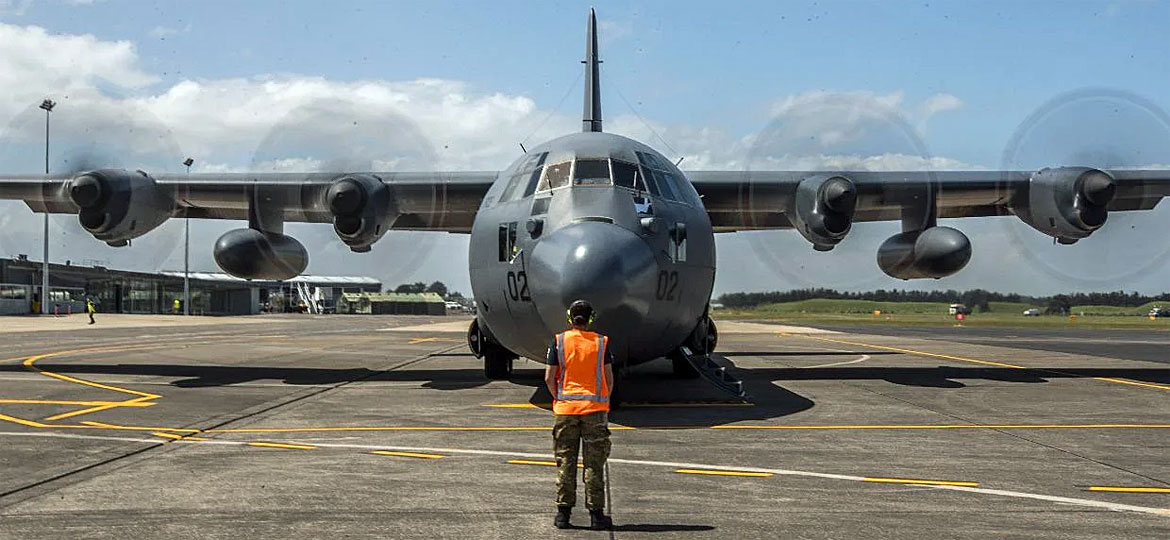
For sale, as is where is: four vintage Hercules aeroplanes that have been lovingly maintained but are past their use-by date. The Defence Force has listed for sale four of the 60-year-old Hercules aircraft, the workhorses of the Air Force fleet, in anticipation of the arrival of five new C-130J Hercules later this year. It was expected the old Hercules would stop being used at the end of January 2025.
A January briefing to Defence Minister Judith Collins, obtained under the Official Information Act, shows the Defence Force intended to sell the transport aircraft and their parts on an “as is where is” basis. Of the total fleet of five Hercules, two had already been withdrawn from service in February and November 2023 due to their age and condition, and to cannibalise them for parts for the remaining three aircraft.
The Defence Force would also look to dispose of parts and specialist tools from the Hercules that could not be sold “due to security or legal considerations”. Any parts that would be of use in the replacement aircraft would be kept.
While four will be sold, the fifth would be provided to the Royal New Zealand Air Force Museum Trust for display at its museum in Wigram, alongside a retired P-3K2 Orion surveillance aircraft - a model of plane recently replaced by new P-8 Poseidon planes. This was deemed appropriate “in view of the long service and immense contribution to New Zealand by the C-130H Hercules aircraft”.
thepost.co.nz
A January briefing to Defence Minister Judith Collins, obtained under the Official Information Act, shows the Defence Force intended to sell the transport aircraft and their parts on an “as is where is” basis. Of the total fleet of five Hercules, two had already been withdrawn from service in February and November 2023 due to their age and condition, and to cannibalise them for parts for the remaining three aircraft.
The Defence Force would also look to dispose of parts and specialist tools from the Hercules that could not be sold “due to security or legal considerations”. Any parts that would be of use in the replacement aircraft would be kept.
While four will be sold, the fifth would be provided to the Royal New Zealand Air Force Museum Trust for display at its museum in Wigram, alongside a retired P-3K2 Orion surveillance aircraft - a model of plane recently replaced by new P-8 Poseidon planes. This was deemed appropriate “in view of the long service and immense contribution to New Zealand by the C-130H Hercules aircraft”.
thepost.co.nz
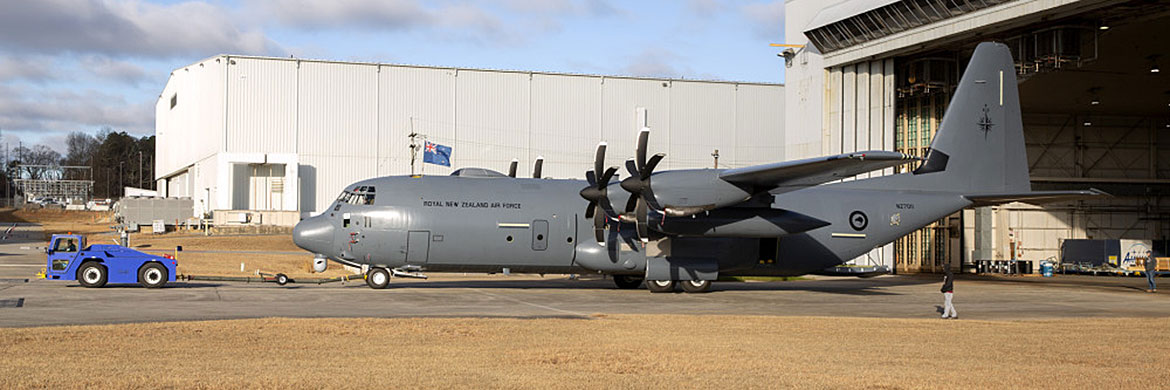
The first of five new RNZAF Hercules C-130J's being taken out of the paint shop in Spain

From: Stephen Davey, Tadcaster, North Yorks
Subject: Flat Floor Loads
Tony,
My recurring nightmare from my days on Air Movements at Brize Norton were the Britannia Dangerous Air Cargo flat floor loads. There were separate piles for all the different UN classes of flashpoints etc., itemising paints, glues, activators like PRC; you get my drift don't you? All these stacks were either lashed down with tape or the small cargo nets which we ended up using in conjunction with tape and quite often scrambling around trying to find enough to finish the job.
The whole aircraft floor looked like a demented mole had been at work, but is it my imagination that our team always got the job when it came to DAC loads? The problem was as some of your readers might agree that it was a very time consuming task and could quite well take a whole shift to complete.
Regards
Steve
Subject: Flat Floor Loads
Tony,
My recurring nightmare from my days on Air Movements at Brize Norton were the Britannia Dangerous Air Cargo flat floor loads. There were separate piles for all the different UN classes of flashpoints etc., itemising paints, glues, activators like PRC; you get my drift don't you? All these stacks were either lashed down with tape or the small cargo nets which we ended up using in conjunction with tape and quite often scrambling around trying to find enough to finish the job.
The whole aircraft floor looked like a demented mole had been at work, but is it my imagination that our team always got the job when it came to DAC loads? The problem was as some of your readers might agree that it was a very time consuming task and could quite well take a whole shift to complete.
Regards
Steve


From: Norman Stamper, Torrevieja
Subject: Flat Floor Loads
Hi Tony,
This month’s topic of "flat floor loads" reminded me of my early days at Lyneham. I can't remember if I was on the newly formed TAC AIR MOVS or Station Movements. It was the day that we had to load boxes of parachutes which were on their way to Southern Germany for a big para-drop exercise. There seemed to be hundreds of never-ending boxes being loaded, stacked and netted! It seemed to take most of the day to complete the job.
Subject: Flat Floor Loads
Hi Tony,
This month’s topic of "flat floor loads" reminded me of my early days at Lyneham. I can't remember if I was on the newly formed TAC AIR MOVS or Station Movements. It was the day that we had to load boxes of parachutes which were on their way to Southern Germany for a big para-drop exercise. There seemed to be hundreds of never-ending boxes being loaded, stacked and netted! It seemed to take most of the day to complete the job.

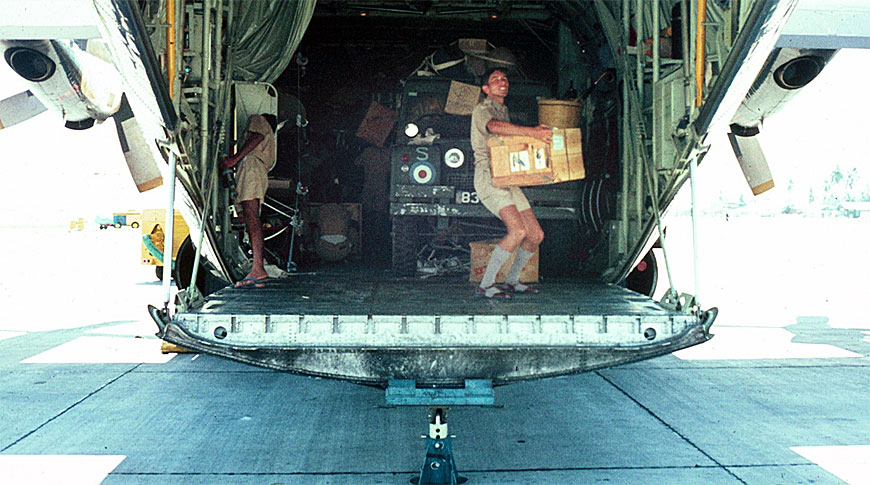
The only Photo I have of a Flat Floor Load is from my time In Gan 1969.
I think that box was the only item added to the already full aircraft.
I think that box was the only item added to the already full aircraft.
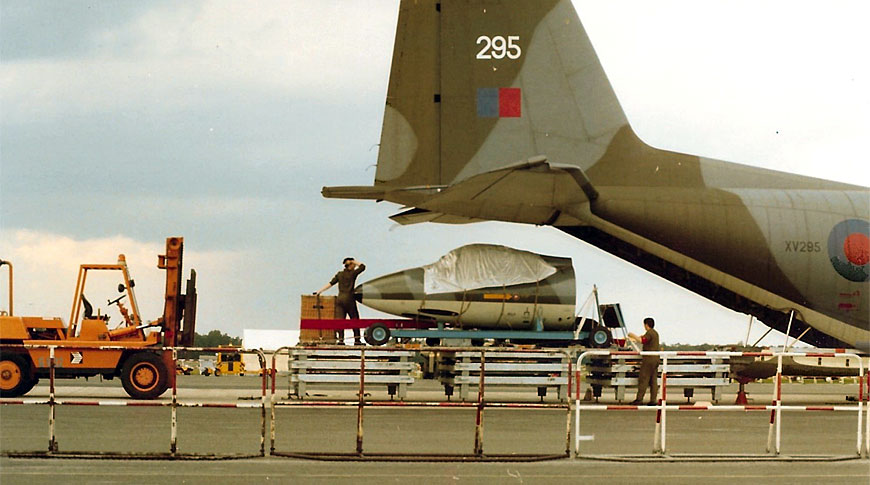
RAF Gatow where we had to improvise loading pallets to an aircraft, as we did not have a Condec;
there was only portable docking held in the storage hangar should there ever be another blockade.
there was only portable docking held in the storage hangar should there ever be another blockade.
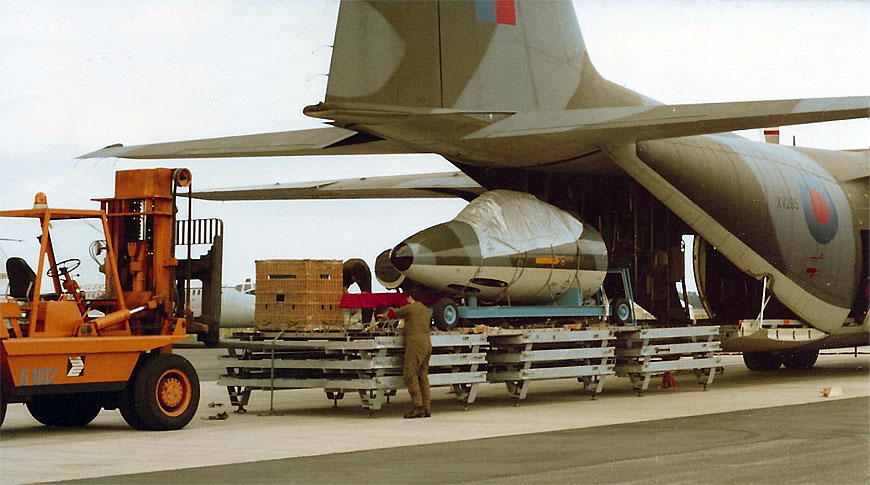
These loads were display items being returned to the UK after the RAF
Open Day on the Unit. The person scratching his head is Mick Sullivan.
Open Day on the Unit. The person scratching his head is Mick Sullivan.
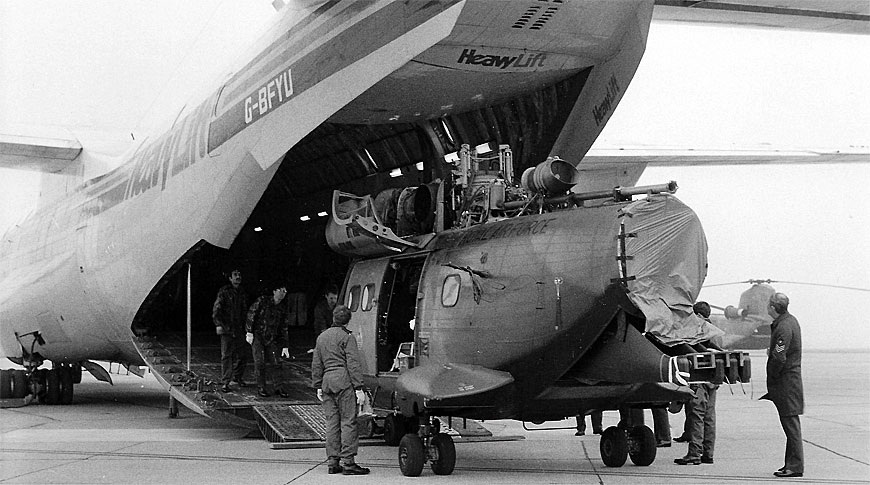
Whilst at RAF Odiham, we loaded two Puma helicopters destined for Belize. The HeavyLift
Belfast then hopped over to Brize Norton to refuel before completing the mission to Belize.
Belfast then hopped over to Brize Norton to refuel before completing the mission to Belize.
All the best,
Norman
Norman
Not sure where or when - a Trianco Transfer Loader being positioned against
a Blackburn Beverley. A Houchin generator provided the lifting power.
a Blackburn Beverley. A Houchin generator provided the lifting power.
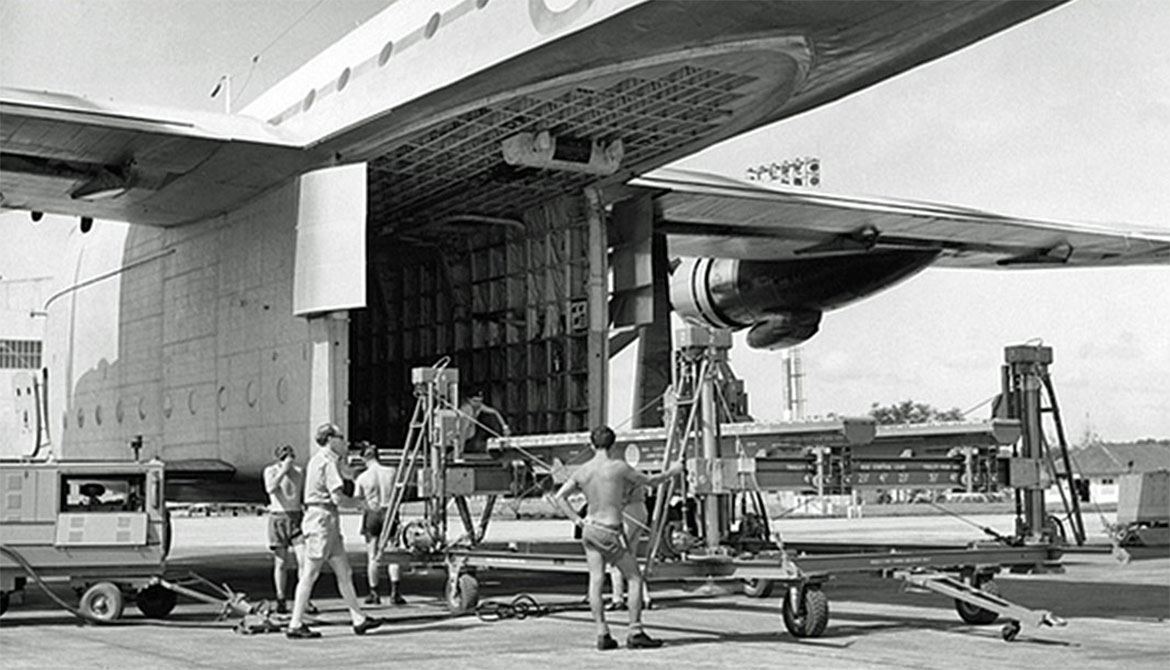
From: Ian Stacey, Nashville, IN
Subject: Flat Floor Loads
Hi Tony,
Your e-mail about flat floor loads brought three horrible words into my memory: “TRIANCO TRANSFER LOADER”.
This horrific device was brand new back in the time I was on UKMAMS and my team was selected to work out ways to load this device in a disassembled state onto an Argosy. Now although it had been designed to come apart into smaller pieces the manufacturers had done absolutely nothing towards considering travel portability.
Unlike the BFLP (Brittania Freight Lift Platform), which when taken apart fitted into a nice four square travelling carriage, this beast consisted of many different odd shaped sub-assemblies with sharp corners and loose wires. It was an absolute bloody nightmare and we spent a whole week trying various methods to successfully tie it down inside the Argosy. My memory of that week is somewhat hazy but I do remember that several members of my team (Sgt Ian Pike for one) got so frustrated that we almost ended up not talking to each other as tempers flared at the difficulty of the task. Anyway – I cannot recall us ever using the loader on forward air head deployment so I assume it never became a popular tool.
Ian Stacey D team – 1964
Subject: Flat Floor Loads
Hi Tony,
Your e-mail about flat floor loads brought three horrible words into my memory: “TRIANCO TRANSFER LOADER”.
This horrific device was brand new back in the time I was on UKMAMS and my team was selected to work out ways to load this device in a disassembled state onto an Argosy. Now although it had been designed to come apart into smaller pieces the manufacturers had done absolutely nothing towards considering travel portability.
Unlike the BFLP (Brittania Freight Lift Platform), which when taken apart fitted into a nice four square travelling carriage, this beast consisted of many different odd shaped sub-assemblies with sharp corners and loose wires. It was an absolute bloody nightmare and we spent a whole week trying various methods to successfully tie it down inside the Argosy. My memory of that week is somewhat hazy but I do remember that several members of my team (Sgt Ian Pike for one) got so frustrated that we almost ended up not talking to each other as tempers flared at the difficulty of the task. Anyway – I cannot recall us ever using the loader on forward air head deployment so I assume it never became a popular tool.
Ian Stacey D team – 1964


Canada Highlights Arctic Aviation Capability with Far-Northern Drills
The Canadian armed forces have concluded a series of annual drills meant to sharpen the country’s military capabilities in the high Arctic. Known as Operation Nanook-Nunalivut, the latest iteration of the exercise ran from 1-17 March and included more than 300 Canadian military personnel, and troops from the USA, Belgium, France and Germany.
Aircraft from the Royal Canadian Air Force (RCAF) were also involved, including Lockheed Martin C-130J Hercules tactical transports and CC-138 Twin Otters, the military designation for De Havilland Canada DHC-6 twin-engined turboprop.
Operation Nanook-Nunalivut is based around the Canadian Armed Forces Arctic Training Centre, located in the small village of Resolute Bay. The community on Cornwallis Island is one of Canada’s most northerly – located just 1,865 miles (3,000km) from the North Pole. Canadian armed forces members also deployed to a research base at Eureka, Nunavut – just 620 miles from the North Pole – and Pond Inlet on the northernmost edge of Baffin Island.
Ottawa says the exercise demonstrated Canada’s ability to project and sustain forces in the Arctic “under the harshest conditions.
“It is increasingly important to be able to project and sustain forces in the Canadian Arctic,” says Vice-Admiral Bob Auchterlonie, commander of Canadian Joint Operations Command. “Operation Nanook-Nunalivut is our opportunity to demonstrate Canada’s presence and sovereignty in the north, while training to operate in austere and difficult environments.”
Canada is in the midst of a major modernisation effort targeting the RCAF, including the procurement of new aerial refuelling, surveillance and fighter aircraft. Ottawa is also investing billions of dollars to build new airspace monitoring radars across the Arctic.
The RCAF’s use of aircraft carrier-oriented fighter platforms also offers unique benefits to Arctic operations. Installation of a ground-based arresting wire system at a US-operated air base in Greenland in 2020 now allows the RCAF’s carrier-capable Boeing F/A-18 Hornet fighters to land year-round on the facility’s icy runways.
flightglobal.com
Aircraft from the Royal Canadian Air Force (RCAF) were also involved, including Lockheed Martin C-130J Hercules tactical transports and CC-138 Twin Otters, the military designation for De Havilland Canada DHC-6 twin-engined turboprop.
Operation Nanook-Nunalivut is based around the Canadian Armed Forces Arctic Training Centre, located in the small village of Resolute Bay. The community on Cornwallis Island is one of Canada’s most northerly – located just 1,865 miles (3,000km) from the North Pole. Canadian armed forces members also deployed to a research base at Eureka, Nunavut – just 620 miles from the North Pole – and Pond Inlet on the northernmost edge of Baffin Island.
Ottawa says the exercise demonstrated Canada’s ability to project and sustain forces in the Arctic “under the harshest conditions.
“It is increasingly important to be able to project and sustain forces in the Canadian Arctic,” says Vice-Admiral Bob Auchterlonie, commander of Canadian Joint Operations Command. “Operation Nanook-Nunalivut is our opportunity to demonstrate Canada’s presence and sovereignty in the north, while training to operate in austere and difficult environments.”
Canada is in the midst of a major modernisation effort targeting the RCAF, including the procurement of new aerial refuelling, surveillance and fighter aircraft. Ottawa is also investing billions of dollars to build new airspace monitoring radars across the Arctic.
The RCAF’s use of aircraft carrier-oriented fighter platforms also offers unique benefits to Arctic operations. Installation of a ground-based arresting wire system at a US-operated air base in Greenland in 2020 now allows the RCAF’s carrier-capable Boeing F/A-18 Hornet fighters to land year-round on the facility’s icy runways.
flightglobal.com
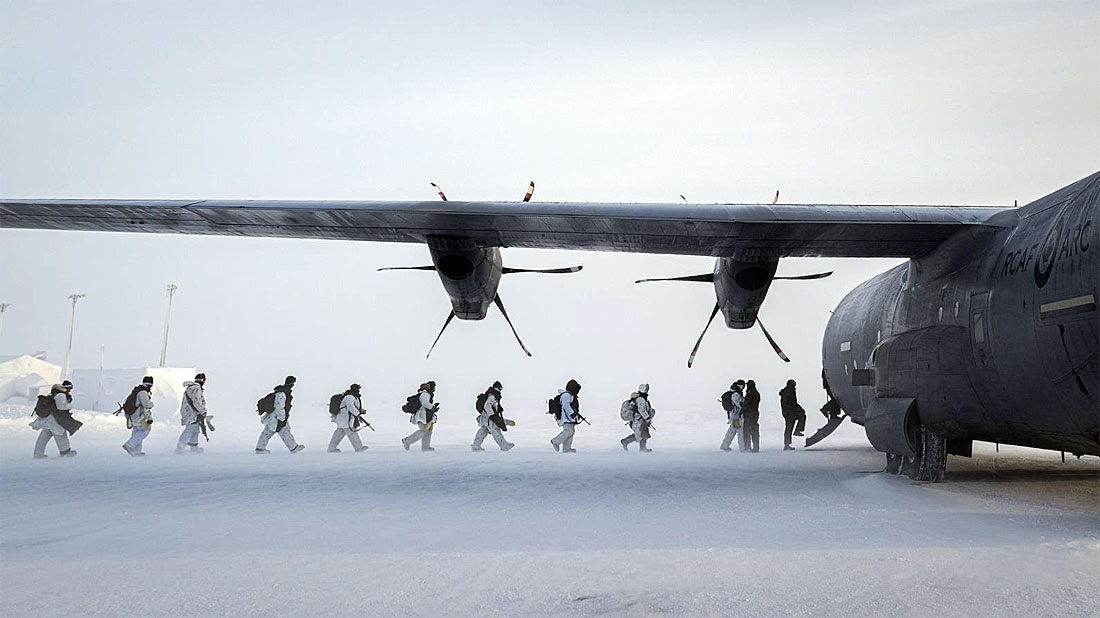
Members of Canada's Arctic Response Company Group board a Royal Canadian Air Force
C-130J transport in Resolute Bay, Nunavut for a mission to Eureka on remote Ellesmere Island.
C-130J transport in Resolute Bay, Nunavut for a mission to Eureka on remote Ellesmere Island.
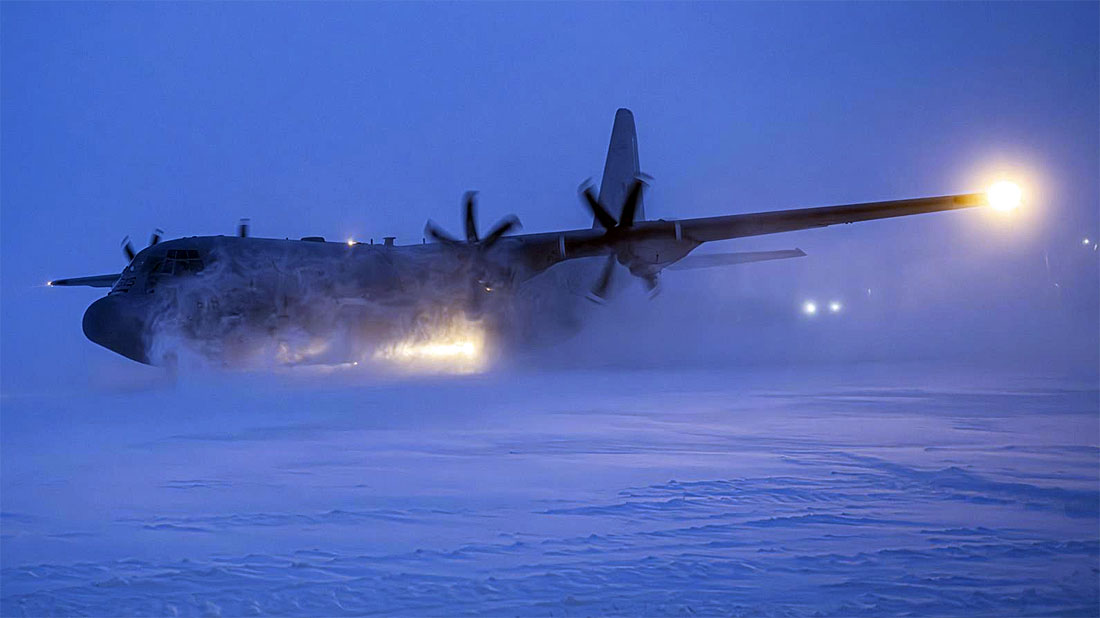
An RCAF C-130 transport lands at the Canadian Armed Forces
Arctic Training Centre in Resolute Bay on Cornwallis Island
Arctic Training Centre in Resolute Bay on Cornwallis Island
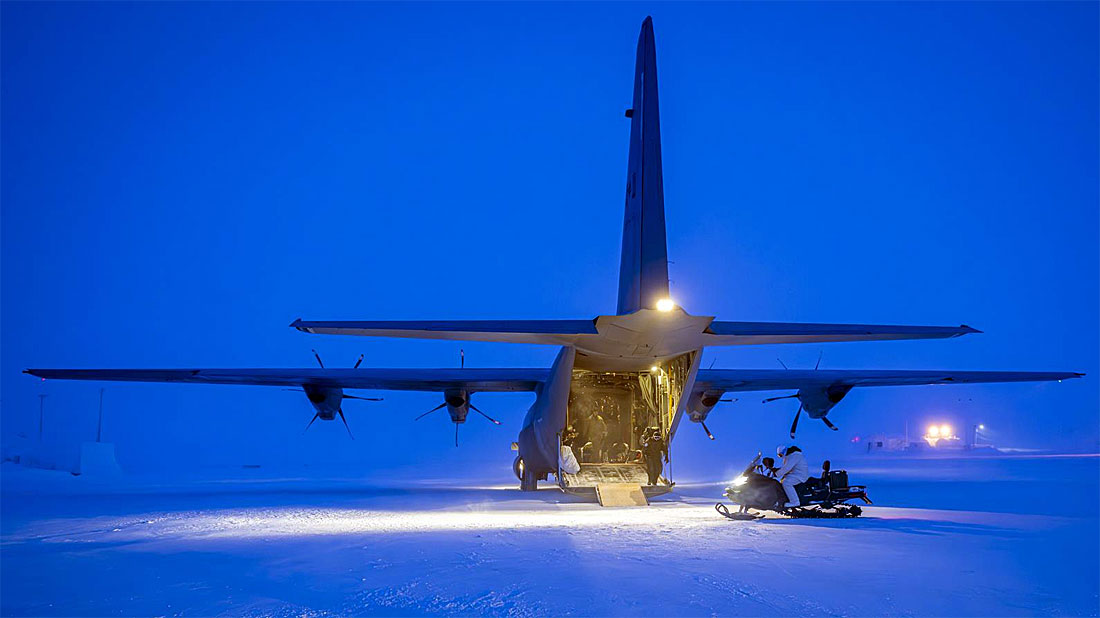
An RCAF C-130 transport lands at the Canadian Armed Forces
Arctic Training Centre in Resolute Bay on Cornwallis Island
Arctic Training Centre in Resolute Bay on Cornwallis Island
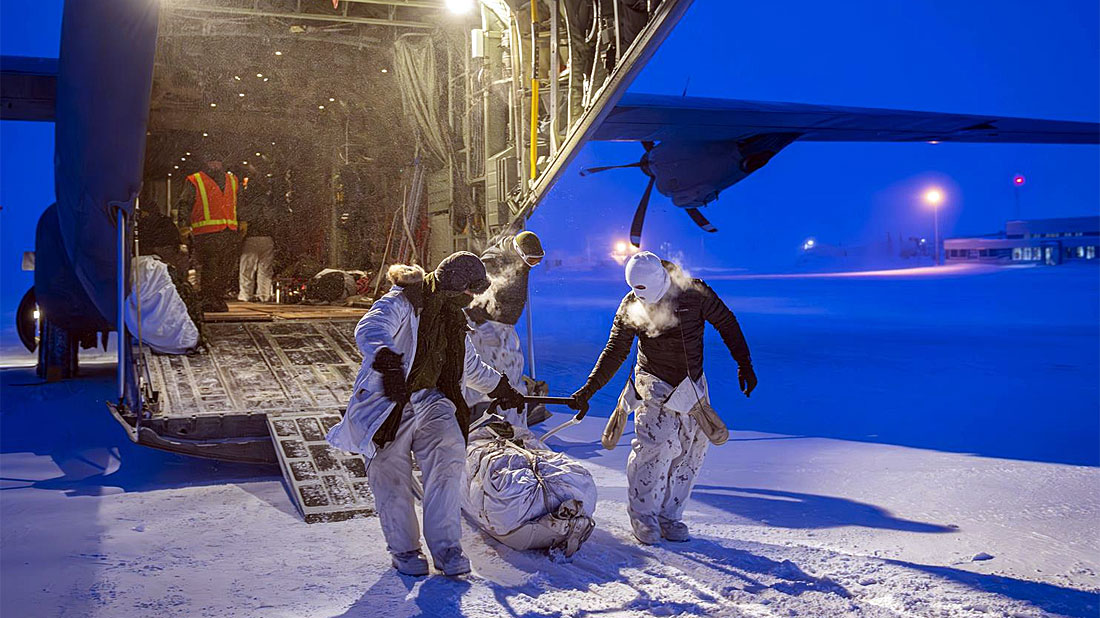
Members of Canada's Arctic Response Company Group arrive at Resolute Bay aboard a Royal
Canadian Air Force C-130J transport after a mission to Eureka on remote Ellesmere Island
Canadian Air Force C-130J transport after a mission to Eureka on remote Ellesmere Island
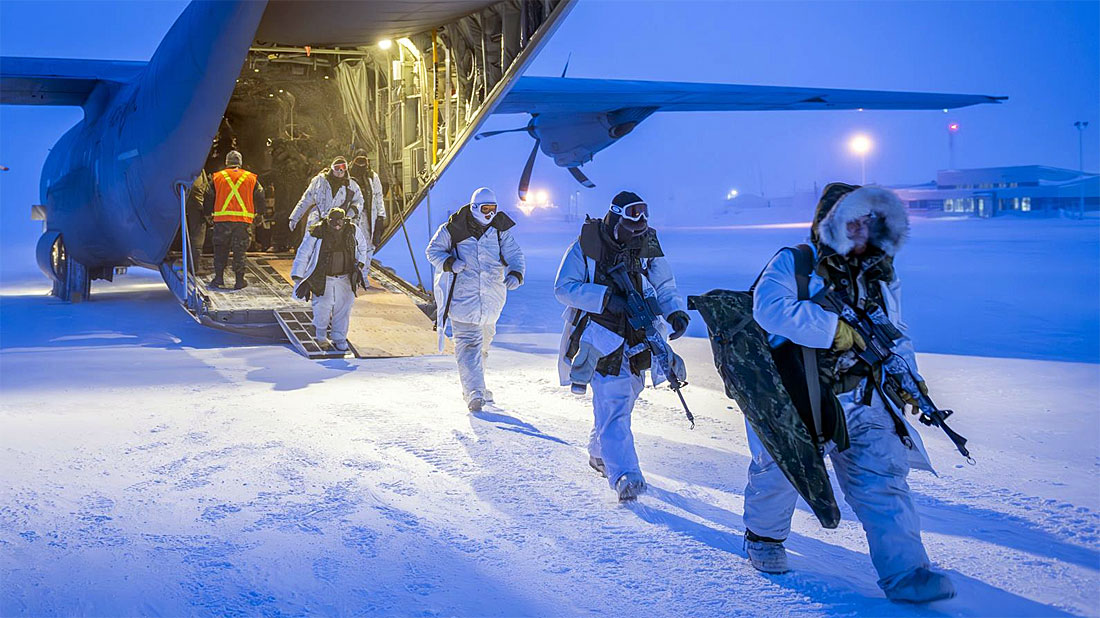
Members of Canada's Arctic Response Company Group arrive at Resolute Bay aboard a Royal
Canadian Air Force C-130J transport after a mission to Eureka on remote Ellesmere Island
Canadian Air Force C-130J transport after a mission to Eureka on remote Ellesmere Island
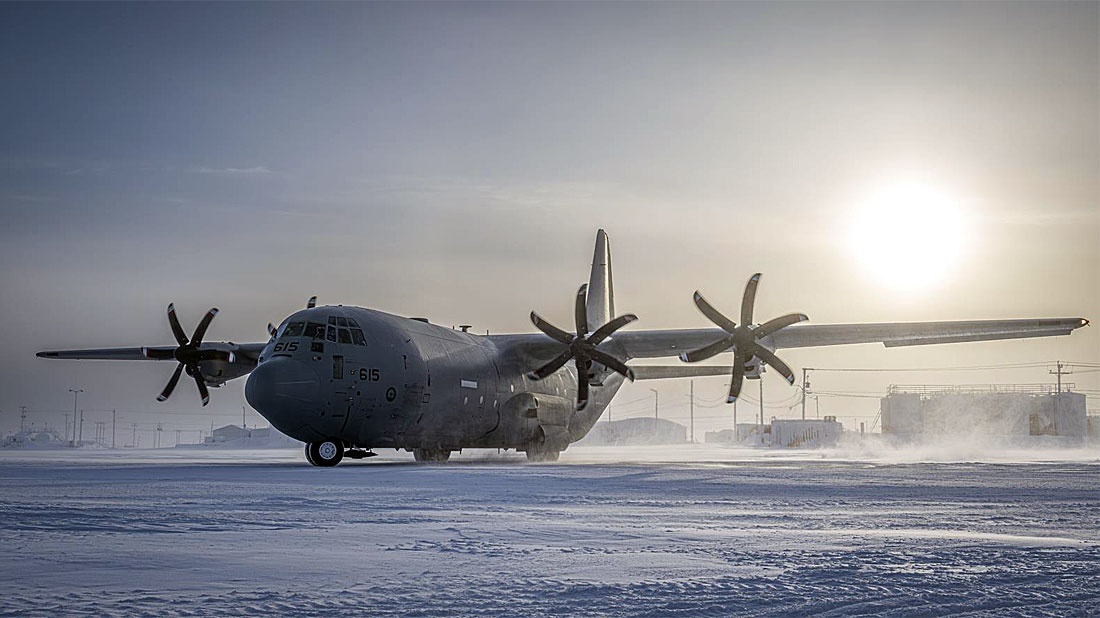
The Royal Canadian Air Force operates 17 C-130J tactical transports, according to
Cirium data, along with seven older C-130H models for search and rescue missions
Cirium data, along with seven older C-130H models for search and rescue missions
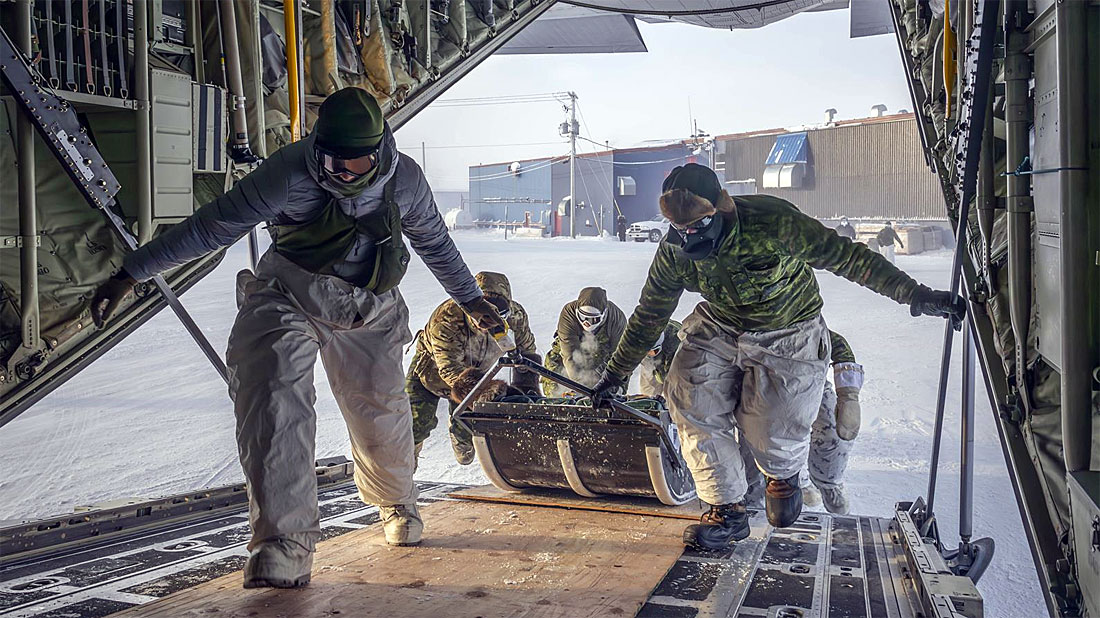
Members of Arctic Response Company Group load supplies into a C-130J Hercules
transport aircraft near the Canadian Armed Forces Arctic Training Centre in Resolute Bay
transport aircraft near the Canadian Armed Forces Arctic Training Centre in Resolute Bay
Members of the Canadian armed forces conducted operations at several locations across
the high Arctic during multi-national training exercises between 1 March and 17 March
the high Arctic during multi-national training exercises between 1 March and 17 March
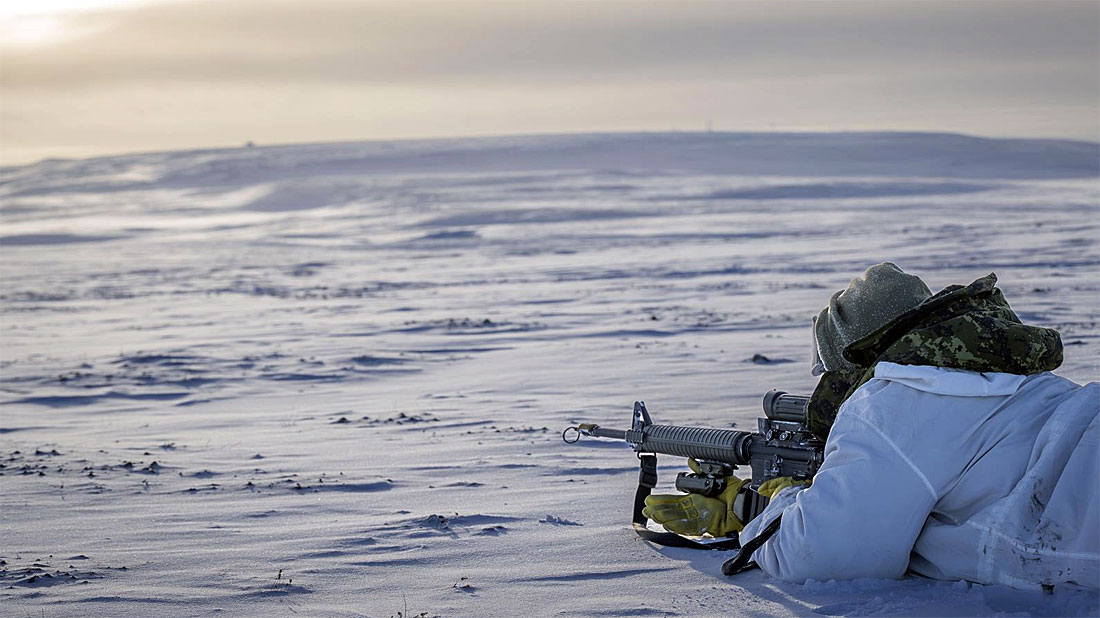

From: Alex Masson, Tunbridge Wells, Kent
Subject: Flat Floor Loads
Hi Tony,
CHRISTMAS ISLAND - WINDING DOWN: We were now well into August 1957 and so it was that, within a week or so, charter planes started to arrive with our replacements. When a replacement arrived the existing soldier/airman would be on the next plane home. My job, along with the others in the Air Movements section, was arranging for the transportation of the returning personnel.
We started to get planes like charter aircraft, Qantas 1049H Constellations VH-EAN, Trans Australia DC4 VH-TAD, Australia National DC4 VH-ANF and Teal Airways from New Zealand DC6 ZK-BGB in as full freighters or passenger aircraft bringing new people in, and taking the old ones away.
When they came again, loaded with sheet steel, for the blast shelters, which were being put up at the south eastern corner of Christmas Island. I remember when I climbed aboard VH-EAN, and I found an empty hold, I said, “Where’s your load?” the reply came back, “You are standing on it?” I looked down and there it was, sheet steel more than two inches thick, and piled on top of one another! We had terrible trouble off-loading the damn stuff. The whole floor was covered right up to half-way along the aircraft. Glyn, Tim, Brummie, Moss and me worked our socks off! Paddy Coughlan on the fork-lift truck and the MT driver, Geordie Nicholson, on the Cole’s mobile Crain were sweating it out. It is a good job that they came in at night, or it might be a different outcome. The heat in the day on those aircraft could easily reach 120 F. or more.
Eventually, when most, if not all, personnel had been replaced, I and my colleague Glyn Duggan, from our section, booked ourselves onto a Qantas charter plane and left Christmas Island for good, on Tuesday 10th September 1957. It was the same plane that had brought me to Christmas Island –VH-EAM.
Alex Masson Cpl
Subject: Flat Floor Loads
Hi Tony,
CHRISTMAS ISLAND - WINDING DOWN: We were now well into August 1957 and so it was that, within a week or so, charter planes started to arrive with our replacements. When a replacement arrived the existing soldier/airman would be on the next plane home. My job, along with the others in the Air Movements section, was arranging for the transportation of the returning personnel.
We started to get planes like charter aircraft, Qantas 1049H Constellations VH-EAN, Trans Australia DC4 VH-TAD, Australia National DC4 VH-ANF and Teal Airways from New Zealand DC6 ZK-BGB in as full freighters or passenger aircraft bringing new people in, and taking the old ones away.
When they came again, loaded with sheet steel, for the blast shelters, which were being put up at the south eastern corner of Christmas Island. I remember when I climbed aboard VH-EAN, and I found an empty hold, I said, “Where’s your load?” the reply came back, “You are standing on it?” I looked down and there it was, sheet steel more than two inches thick, and piled on top of one another! We had terrible trouble off-loading the damn stuff. The whole floor was covered right up to half-way along the aircraft. Glyn, Tim, Brummie, Moss and me worked our socks off! Paddy Coughlan on the fork-lift truck and the MT driver, Geordie Nicholson, on the Cole’s mobile Crain were sweating it out. It is a good job that they came in at night, or it might be a different outcome. The heat in the day on those aircraft could easily reach 120 F. or more.
Eventually, when most, if not all, personnel had been replaced, I and my colleague Glyn Duggan, from our section, booked ourselves onto a Qantas charter plane and left Christmas Island for good, on Tuesday 10th September 1957. It was the same plane that had brought me to Christmas Island –VH-EAM.
Alex Masson Cpl

Lockheed 1049H Constellation VH-EAN at Sydney in 1960
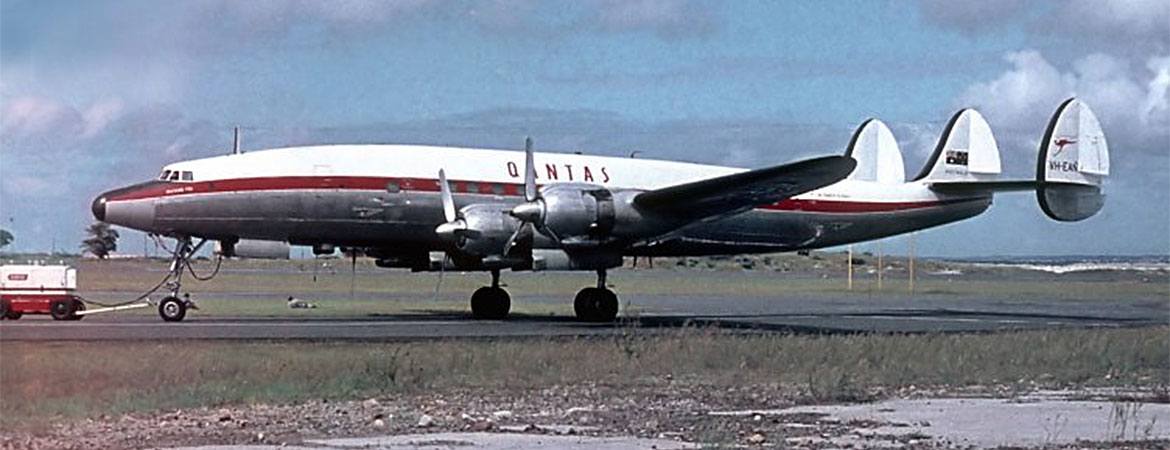

From: Mick Craner, Yeovil, Somerset
Subject: Flat Floor Loads
Hello Tony,
Flat floor loads takes me back to my Air Quartermaster days on 48Sqn Hastings at Changi 64/67. The Hastings was without doubt the most difficult aircraft to load through a side door and uphill. The Plymax floor was easily damaged with heavy items.
I recall a detachment to Kuching, Borneo, for supply dropping to our lads in the Jungle. One particular load was ten 45 gallon drums of helicopter fuel, loaded by the excellent Army boys. Each drum had to be manhandled to the door to be dispatched by parachute, leaning the drum and moving it on its rim caused considerable damage to the floor, coupled with the fact that we were airborne with the aircraft bouncing about.
On return to Kuching with all drums delivered, I noticed a piece of floor was damaged and would have to be secured. I said with misplaced humour, “That needs to be nailed down.” I was overheard by a young army lad who did just that, he nailed it down! Fortunately he missed the elevator and rudder controls that passed underneath.
My next posting was to the first class Hercules - what a difference!
All the Very Best,
Mick
Subject: Flat Floor Loads
Hello Tony,
Flat floor loads takes me back to my Air Quartermaster days on 48Sqn Hastings at Changi 64/67. The Hastings was without doubt the most difficult aircraft to load through a side door and uphill. The Plymax floor was easily damaged with heavy items.
I recall a detachment to Kuching, Borneo, for supply dropping to our lads in the Jungle. One particular load was ten 45 gallon drums of helicopter fuel, loaded by the excellent Army boys. Each drum had to be manhandled to the door to be dispatched by parachute, leaning the drum and moving it on its rim caused considerable damage to the floor, coupled with the fact that we were airborne with the aircraft bouncing about.
On return to Kuching with all drums delivered, I noticed a piece of floor was damaged and would have to be secured. I said with misplaced humour, “That needs to be nailed down.” I was overheard by a young army lad who did just that, he nailed it down! Fortunately he missed the elevator and rudder controls that passed underneath.
My next posting was to the first class Hercules - what a difference!
All the Very Best,
Mick
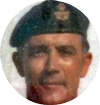
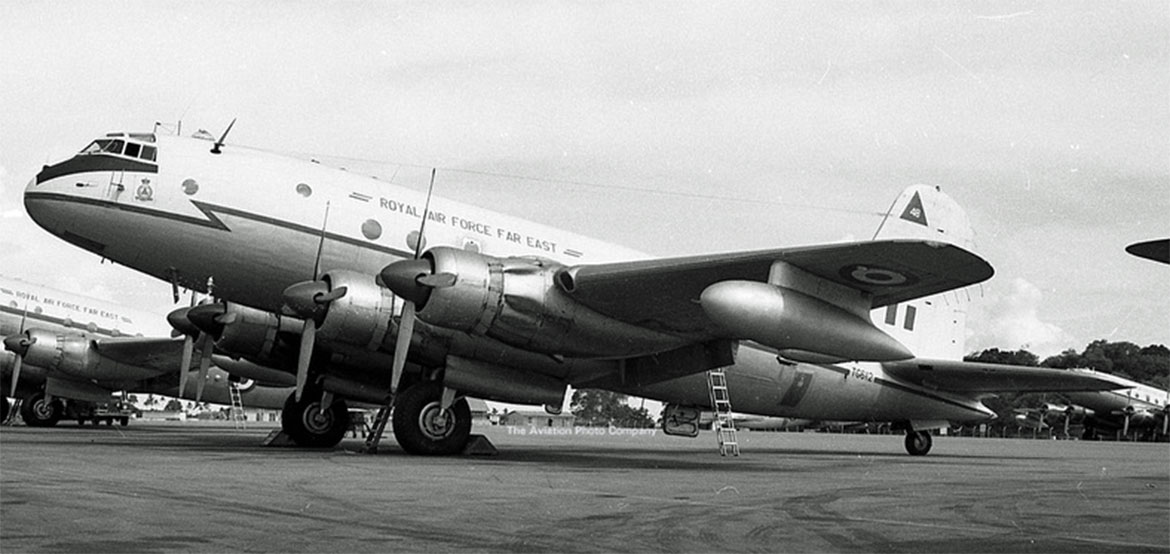
A 48 Squadron Hastings at Changi in 1966

From: David Powell, Princes Risborough, Bucks
Subject: Flat Floor Load Memories
Hello Tony,
Ir’s really great to see that you are back on the bridge of HMS Old Bods! You asked for memories/nightmares of flat floor loads. My first memory, still pretty vivid, was for me genuinely life changing or should it be life-shaping?
As some of you know and most have probably guessed, my initial/professional RAF training after leaving school was 3 years, as it was then, at the RAF College Cranwell 1961/64. The course included preparing a few of us young potential officer sprogs for a career in the RAF Equipment branch. As light relief from the intricate life patterns of RAF forms 674 etc., as we prepared for our first tour on a unit supply squadron, in the final year we were exposed to training for Explosives and Movements specialist qualifications. So, in March 1964, five young flight cadets of Number 85 Entry turned up at RAF Lynam Air Movements Squadron for a few days practical experience before our Easter 1964 break.
At the time RAF Lynham was the home to the RAF’s Britannia and Comet 4 fleets. Of our five cadets there were 4 with their eyes set on a career to the top as professional equippers; 40% (that’s more impressive than just 2) did make Air rank, but not me! Thank goodness.
Anyway, on our last day with our respective shifts at Lyneham, all hell broke loose with yet another Cyprus emergency. This triggered a major airlift to Akrotiri of Army soldiers and equipment using the Britannia fleet. Many of the departures were in the flat floor PCF role, usually with two or three Land Rovers/trailers ahead of a few rows of triple seats for their owners.
Subject: Flat Floor Load Memories
Hello Tony,
Ir’s really great to see that you are back on the bridge of HMS Old Bods! You asked for memories/nightmares of flat floor loads. My first memory, still pretty vivid, was for me genuinely life changing or should it be life-shaping?
As some of you know and most have probably guessed, my initial/professional RAF training after leaving school was 3 years, as it was then, at the RAF College Cranwell 1961/64. The course included preparing a few of us young potential officer sprogs for a career in the RAF Equipment branch. As light relief from the intricate life patterns of RAF forms 674 etc., as we prepared for our first tour on a unit supply squadron, in the final year we were exposed to training for Explosives and Movements specialist qualifications. So, in March 1964, five young flight cadets of Number 85 Entry turned up at RAF Lynam Air Movements Squadron for a few days practical experience before our Easter 1964 break.
At the time RAF Lynham was the home to the RAF’s Britannia and Comet 4 fleets. Of our five cadets there were 4 with their eyes set on a career to the top as professional equippers; 40% (that’s more impressive than just 2) did make Air rank, but not me! Thank goodness.
Anyway, on our last day with our respective shifts at Lyneham, all hell broke loose with yet another Cyprus emergency. This triggered a major airlift to Akrotiri of Army soldiers and equipment using the Britannia fleet. Many of the departures were in the flat floor PCF role, usually with two or three Land Rovers/trailers ahead of a few rows of triple seats for their owners.

This is where I learnt at first hand the subtleties of the 1 pause, 2 pause and 3 lift and heave, to maneuver a Land Rover from the side loading Britannia Freight Lift Platform (the Condec 25K was still a movers’ pipe dream) under the raised cabin port-side freight door while simultaneously turning the vehicle through 90 degrees for the squeeze into the Brit’s main cabin. To those brought up on pallets and rollers, the ‘lift’ reduced the weight/and friction on the Land Rover’s 4 tires. This enabled the ‘heave’ to slide the now lighter loaded vehicle a foot or so in a tight pirouetting circular 90 degree path. Deep breath and repeat and slide until the Land Rover was safely inside the aircraft.
At the end of our attachment to our respective shifts, we were to go back to Cranwell and then disperse to start our three-week Easter leave. Cranwell then really did behave like a College! The idea was to get us all fired-up for our final term and graduation before starting out in the real world. In retrospect, how did I have gall, but, totally caught up in the excitement, I asked if I could stay on at Lyneham for a few more days? Duly granted! They were really shorthanded. One still vivid memory was being in the cargo shed with just two us dragging the load for the following early morning scheduled freight: myself and the SAMO, ‘Sqn Ldr Dad’ Owens who was driving the Fork Lift.
Operational loads, working with really professional and welcoming movers settled it for me. To hell with the excitement of stocktaking, this was where I wanted to be. However, during my 30 months on my first tour at RAF Changi, although nominally in SCAF, I did manage to spend some time in the field as a forward base Supplier/Mover. Also I occasionally got called in by Station Movements to sign off an explosive load in the event of an absence of an available qualified Movement’s Officer. Then after a few months with RAF Abingdon’s station movements, and some 3 years after leaving Cranwell, and I became the first Cranwell Flight Cadet to be able to say I am a MAMS team leader. Sometimes, I wonder how dull life would have been if we had gone to Lyneham the previous week.
Stay safe Tony and don’t rush the mending stuff.
David Powell
F Team UKMAMS RAF Abingdon 1967-69
At the end of our attachment to our respective shifts, we were to go back to Cranwell and then disperse to start our three-week Easter leave. Cranwell then really did behave like a College! The idea was to get us all fired-up for our final term and graduation before starting out in the real world. In retrospect, how did I have gall, but, totally caught up in the excitement, I asked if I could stay on at Lyneham for a few more days? Duly granted! They were really shorthanded. One still vivid memory was being in the cargo shed with just two us dragging the load for the following early morning scheduled freight: myself and the SAMO, ‘Sqn Ldr Dad’ Owens who was driving the Fork Lift.
Operational loads, working with really professional and welcoming movers settled it for me. To hell with the excitement of stocktaking, this was where I wanted to be. However, during my 30 months on my first tour at RAF Changi, although nominally in SCAF, I did manage to spend some time in the field as a forward base Supplier/Mover. Also I occasionally got called in by Station Movements to sign off an explosive load in the event of an absence of an available qualified Movement’s Officer. Then after a few months with RAF Abingdon’s station movements, and some 3 years after leaving Cranwell, and I became the first Cranwell Flight Cadet to be able to say I am a MAMS team leader. Sometimes, I wonder how dull life would have been if we had gone to Lyneham the previous week.
Stay safe Tony and don’t rush the mending stuff.
David Powell
F Team UKMAMS RAF Abingdon 1967-69
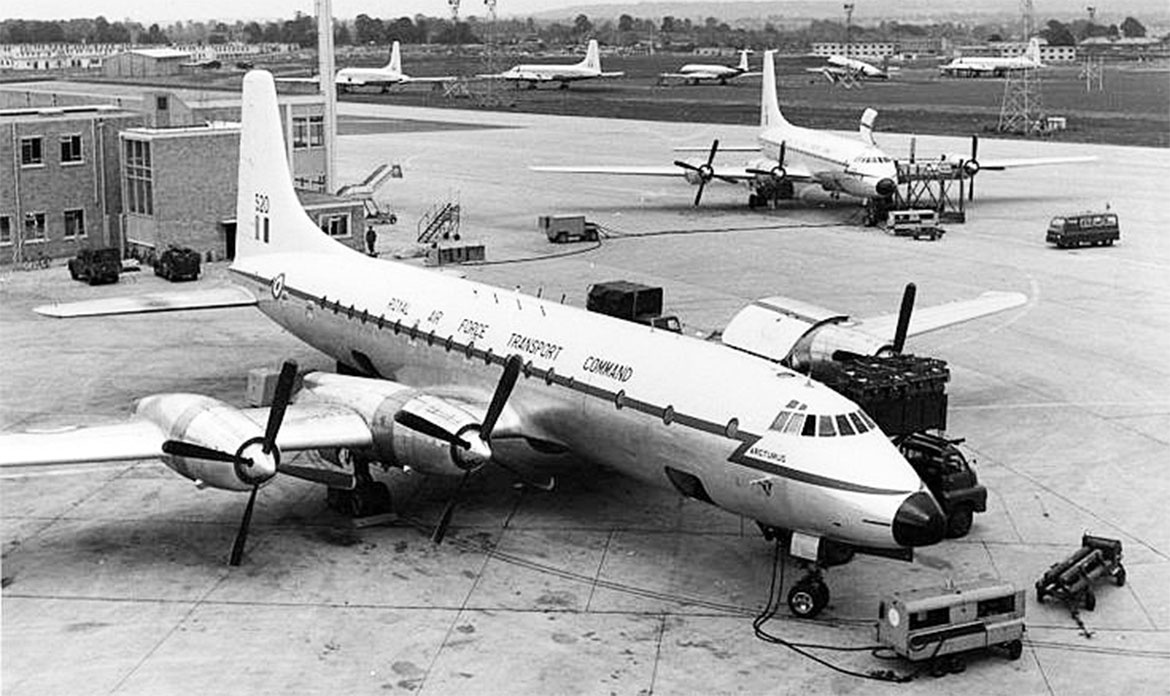
Britannia's at RAF Lyneham in the 1960's. In the distance are also a Comet and a Hastings

From: Gerry Davis, Bedminster, Glos
Subject: Flat Floor Loads
Hi Tony,
During my three years at RAF Benson, 1962-65, four Argosy Squadrons were formed, then one went to the Far East and one to the Middle East.
It used to be a busy time at Benson for the three loading teams with daily loads. Normally the Argosy had a box of chains and side guidance fitted, which took up a good portion of the available payload. Nearly all our loads were flat floor which always seemed to be hard physical work. Passenger figures were hardly noticeable, except sometimes a load of Paratroopers.
Gerry Davis
Subject: Flat Floor Loads
Hi Tony,
During my three years at RAF Benson, 1962-65, four Argosy Squadrons were formed, then one went to the Far East and one to the Middle East.
It used to be a busy time at Benson for the three loading teams with daily loads. Normally the Argosy had a box of chains and side guidance fitted, which took up a good portion of the available payload. Nearly all our loads were flat floor which always seemed to be hard physical work. Passenger figures were hardly noticeable, except sometimes a load of Paratroopers.
Gerry Davis

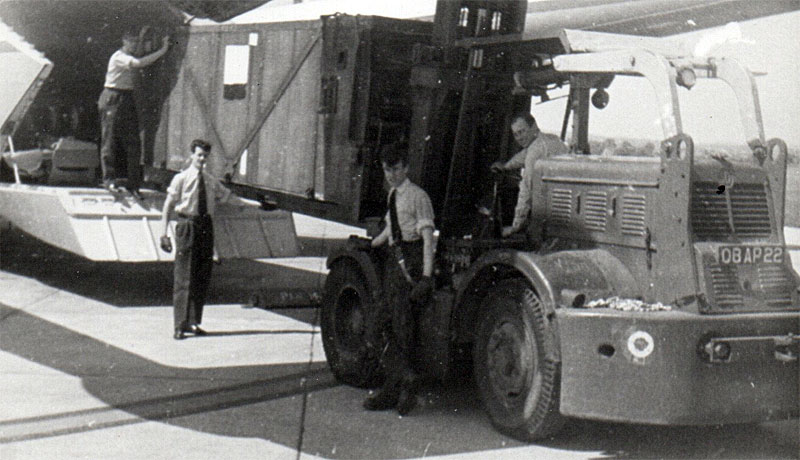
Loading a crated jet engine on the weekly Argosy run to
Wildenrath in Germany. Yours truly clutching the fork lift.
Wildenrath in Germany. Yours truly clutching the fork lift.

From: Michael (OBie) O'Brien, Sanctuary Point, NSW
Subject: Flat Floor Loads
G’Day Tony, and happy to see you back at the coal-face … but, take it easy, eh!
I was involved in the following task , mostly for encouragement and complimentary accolades, however my colleague, who’s ex-RAF and RAAF, and a Member of this erstwhile Association also, had the dubious honour as OC Phnom Penh/Pochentong AirBase MovCon Det to attempt to herd all the cats various, in order to have all run smoothly … he may care to further elucidate ...
This particular occasion was one of the UNTAC Movement Control Group serials in support of “OP Wishbone”, the weapons cantonment in which foodstuffs were exchanged for the squabbling factions’ surrendering of their weapons [altogether another story!] during May-July ’92. Usually the Mission’s contracted Mi-8/Mi-17s were employed, however in a couple of instances involving larger factional groups, the Mi-26s contracted from AeroLift/Hevi Lift, were put to use as their 20t uplift capability certainly trumped the Mi-8/Mi-17s ~2t uplifts. That said, floor-loading in the middle of Cambodia’s 30+ degree C/90% humidity wet season somewhat reduced the anticipation and satisfaction of a job well-done.
The photos depict the 20t of floor-loaded cargo, comprising a mix of rice, tinned fish, oil and miscellaneous ’stuff'. Those involved, apart from the Australian Movement Control Group personnel, included local labour, the French Air Force BOMAP and their handling equipment, the Canadian PPLI 92éme Transport Coy, and the contracted-aircrew from AeroLift/Hevi Lift.
Subject: Flat Floor Loads
G’Day Tony, and happy to see you back at the coal-face … but, take it easy, eh!
I was involved in the following task , mostly for encouragement and complimentary accolades, however my colleague, who’s ex-RAF and RAAF, and a Member of this erstwhile Association also, had the dubious honour as OC Phnom Penh/Pochentong AirBase MovCon Det to attempt to herd all the cats various, in order to have all run smoothly … he may care to further elucidate ...
This particular occasion was one of the UNTAC Movement Control Group serials in support of “OP Wishbone”, the weapons cantonment in which foodstuffs were exchanged for the squabbling factions’ surrendering of their weapons [altogether another story!] during May-July ’92. Usually the Mission’s contracted Mi-8/Mi-17s were employed, however in a couple of instances involving larger factional groups, the Mi-26s contracted from AeroLift/Hevi Lift, were put to use as their 20t uplift capability certainly trumped the Mi-8/Mi-17s ~2t uplifts. That said, floor-loading in the middle of Cambodia’s 30+ degree C/90% humidity wet season somewhat reduced the anticipation and satisfaction of a job well-done.
The photos depict the 20t of floor-loaded cargo, comprising a mix of rice, tinned fish, oil and miscellaneous ’stuff'. Those involved, apart from the Australian Movement Control Group personnel, included local labour, the French Air Force BOMAP and their handling equipment, the Canadian PPLI 92éme Transport Coy, and the contracted-aircrew from AeroLift/Hevi Lift.
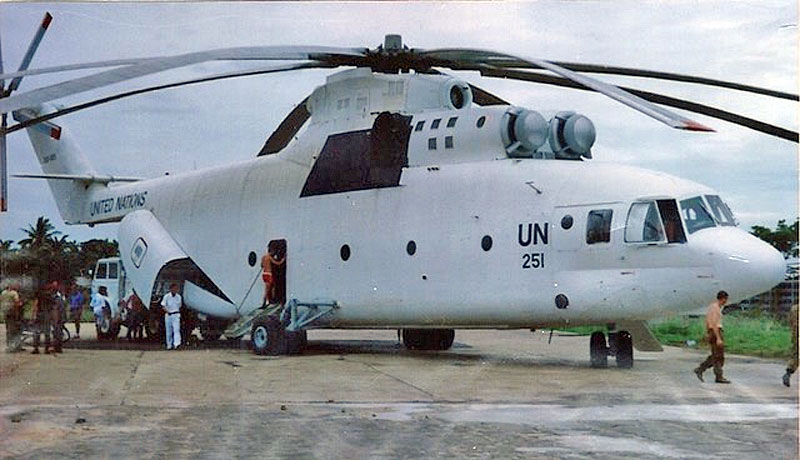

Another [non-UNTAC] task, and not technically a “Floor Load” per se, but which had similar requirements and required considerable mandraulic effort, that we managed in July ’92 was the transfer of the "Age of Angkor: Treasures from the National Museum of Cambodia” cultural artefacts from Phnom Penh’s Fine Arts Museum, to the Australian National Museum for exhibition. These National treasures had been resurrected from the Fine Arts Museum, where they had been ‘stored' during the terror reign of Pol Pot during 1975-’79, and the years following, until such time as they could be retrieved and restored. The Museum had fallen into disrepair over the ensuing decade-plus until the Australian Government, and other historical agencies were able to assist the Cambodian Government to bring the Treasures back into the light. The artefacts were to be sent to Canberra for loan/display on behalf of the Cambodian Government.
This task involved considerable coordination, diplomatically and physically, as the artefacts had to be prepared and packed in accordance with the appropriate cultural reverence and industry best-practice to meet the transport modes’ requirements: road transport from the Fine Arts Museum to Pochentong Airport for uplift by RAAF C-130 to Bangkok for cross-load to QANTAS commercial air, then further road-transport upon arrival at Canberra.
Preparation for the transportation involved working with the Khmer Museum and Australian Government personnel, and albeit a great honour to be consulted, the task soon wore thin as the Museum buildings as well as having very little electrical and water infrastructure left/working, had been used, variously, over the years as: a piggery; a haven for millions of bats and their fleas; a displaced-persons sanctuary, and home for myriads of ‘interesting wildlife’, all of which contributed to an unsafe, unsanitary and aromatic workspace; that said, I was fortunate to not have to spend as much time as the cultural and treasure restitution staff, to be sure!
Whilst not a complete floor-load onto the RAAF C-130, the uplift required many of the attributes of such, as the load had to be ‘consolidated’ on the tarmac adjacent to the C-130, based on the Australian Museum Director’s plans, as it arrived on trucks from the Museum, then be positioned/managed onto 3x B-747 flexi-pallets to enable cross-loading at Bangkok onto the commercial QANTAS flight to Canberra. Thus 'civil-air configured', the crated load then had to be fork-lifted and 'dunnaged & attached’ securely onto three C-130 ‘436-L’-pallets, each of which had an 18” each-end overhang, to fit securely into the C-130s BP System. Some floor-loading of smaller crates then ensured maximisation of the C-130's capability and the safe transport of the numerous and multi-sized/shaped and weight antiquities.
We were most fortunate to enjoy the “assistance” in this tasking of the numerous Khmer and Australian diplomatic and cultural advisers, of varying degrees of concern/mother-henning/getting-in-the-way-phototaking. The exhibition in Canberra went very well, and generated a considerable amount of interest and resources to assist the Cambodian Government’s efforts to preserve their history.
All the best,
OBie
This task involved considerable coordination, diplomatically and physically, as the artefacts had to be prepared and packed in accordance with the appropriate cultural reverence and industry best-practice to meet the transport modes’ requirements: road transport from the Fine Arts Museum to Pochentong Airport for uplift by RAAF C-130 to Bangkok for cross-load to QANTAS commercial air, then further road-transport upon arrival at Canberra.
Preparation for the transportation involved working with the Khmer Museum and Australian Government personnel, and albeit a great honour to be consulted, the task soon wore thin as the Museum buildings as well as having very little electrical and water infrastructure left/working, had been used, variously, over the years as: a piggery; a haven for millions of bats and their fleas; a displaced-persons sanctuary, and home for myriads of ‘interesting wildlife’, all of which contributed to an unsafe, unsanitary and aromatic workspace; that said, I was fortunate to not have to spend as much time as the cultural and treasure restitution staff, to be sure!
Whilst not a complete floor-load onto the RAAF C-130, the uplift required many of the attributes of such, as the load had to be ‘consolidated’ on the tarmac adjacent to the C-130, based on the Australian Museum Director’s plans, as it arrived on trucks from the Museum, then be positioned/managed onto 3x B-747 flexi-pallets to enable cross-loading at Bangkok onto the commercial QANTAS flight to Canberra. Thus 'civil-air configured', the crated load then had to be fork-lifted and 'dunnaged & attached’ securely onto three C-130 ‘436-L’-pallets, each of which had an 18” each-end overhang, to fit securely into the C-130s BP System. Some floor-loading of smaller crates then ensured maximisation of the C-130's capability and the safe transport of the numerous and multi-sized/shaped and weight antiquities.
We were most fortunate to enjoy the “assistance” in this tasking of the numerous Khmer and Australian diplomatic and cultural advisers, of varying degrees of concern/mother-henning/getting-in-the-way-phototaking. The exhibition in Canberra went very well, and generated a considerable amount of interest and resources to assist the Cambodian Government’s efforts to preserve their history.
All the best,
OBie
From: Duane Bach, Trenton, ON
Subject: Flat Floor Loads
Good Morning Tony,
My contribution to these horrible Flat Floor Loads is that in 1984 almost 10,000 Caribou drowned crossing a river about 1,000 km north of Montreal. These caribou were lying in the Caniapiscau and Koksoak rivers after having been swept to their deaths over Limestone Falls as they tried to cross upstream.
The company that had the contract to fly the carcasses out could not fulfil their contract as warmer temperatures were starting to allow the frozen caribou to thaw and this would contaminate the area's water supply.
In August 1985, I was at 426 Sqn as a Loadmaster Instructor and we formed a crew along with 436 Sqn x 2 and we were dispatched to Dorval airport in Montreal. Our first flight showed the MAMS personnel would load each pallet with 3 or 4 x 1,000 - 1,800 lb carcasses and wrap it in plastic. They were thawing well at this time and the flight to Dorval from Fort Chimo was 3.3 hrs.
After day 1 they ran out of plastic wrap so just the bloated and leaking carcasses were dragged onto the pallets, the heads and hooves were chainsawed off Freddy Kruger style. We ran a 24-hour op with the 3 crews. The cargo floor was running with fluid and rot from the carcasses and the loads would bloat out on the way down and a few times I had to use the crash axe to chop the caribou to get them past the ADS arms. I did not ride in the back during the flight as the fluid and smell was not pleasant, but I did stand in the back for take-off and landing and the fluids would run down to the ramp when we went in the takeoff roll, I would have a little dam of fluids at the ramp hinge.
A company bought the carcasses for 5 cents a pound and made it into dog food. When the operation was over the aircraft had to have the floors removed and cleaned, we got a letter about a week later to turn all our flight gear into supply and draw new also to go to the hospital for a shot due to some parasite that the caribou would produce... Yes Sir... Good Times... I couldn't eat meat for a month!
Cheers,
Duane
Subject: Flat Floor Loads
Good Morning Tony,
My contribution to these horrible Flat Floor Loads is that in 1984 almost 10,000 Caribou drowned crossing a river about 1,000 km north of Montreal. These caribou were lying in the Caniapiscau and Koksoak rivers after having been swept to their deaths over Limestone Falls as they tried to cross upstream.
The company that had the contract to fly the carcasses out could not fulfil their contract as warmer temperatures were starting to allow the frozen caribou to thaw and this would contaminate the area's water supply.
In August 1985, I was at 426 Sqn as a Loadmaster Instructor and we formed a crew along with 436 Sqn x 2 and we were dispatched to Dorval airport in Montreal. Our first flight showed the MAMS personnel would load each pallet with 3 or 4 x 1,000 - 1,800 lb carcasses and wrap it in plastic. They were thawing well at this time and the flight to Dorval from Fort Chimo was 3.3 hrs.
After day 1 they ran out of plastic wrap so just the bloated and leaking carcasses were dragged onto the pallets, the heads and hooves were chainsawed off Freddy Kruger style. We ran a 24-hour op with the 3 crews. The cargo floor was running with fluid and rot from the carcasses and the loads would bloat out on the way down and a few times I had to use the crash axe to chop the caribou to get them past the ADS arms. I did not ride in the back during the flight as the fluid and smell was not pleasant, but I did stand in the back for take-off and landing and the fluids would run down to the ramp when we went in the takeoff roll, I would have a little dam of fluids at the ramp hinge.
A company bought the carcasses for 5 cents a pound and made it into dog food. When the operation was over the aircraft had to have the floors removed and cleaned, we got a letter about a week later to turn all our flight gear into supply and draw new also to go to the hospital for a shot due to some parasite that the caribou would produce... Yes Sir... Good Times... I couldn't eat meat for a month!
Cheers,
Duane
Caribou carcasses are pulled from the Caniapiscau River in northern Quebec. They were among
almost 10,000 that drowned. This photo was published in the Montreal Gazette on Oct. 5, 1984.
almost 10,000 that drowned. This photo was published in the Montreal Gazette on Oct. 5, 1984.
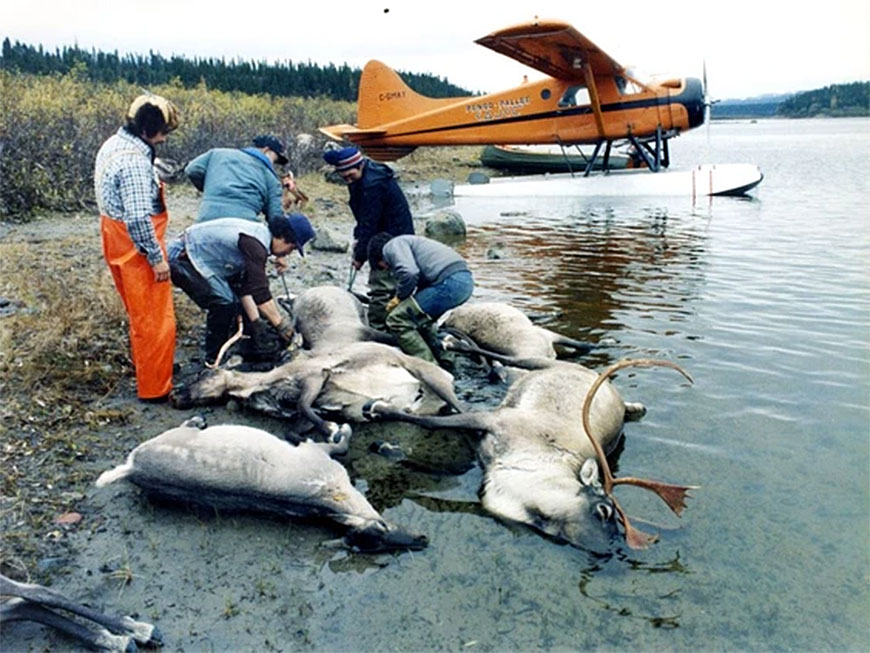

HRH The Princess Royal opens UK facility on UAE air base
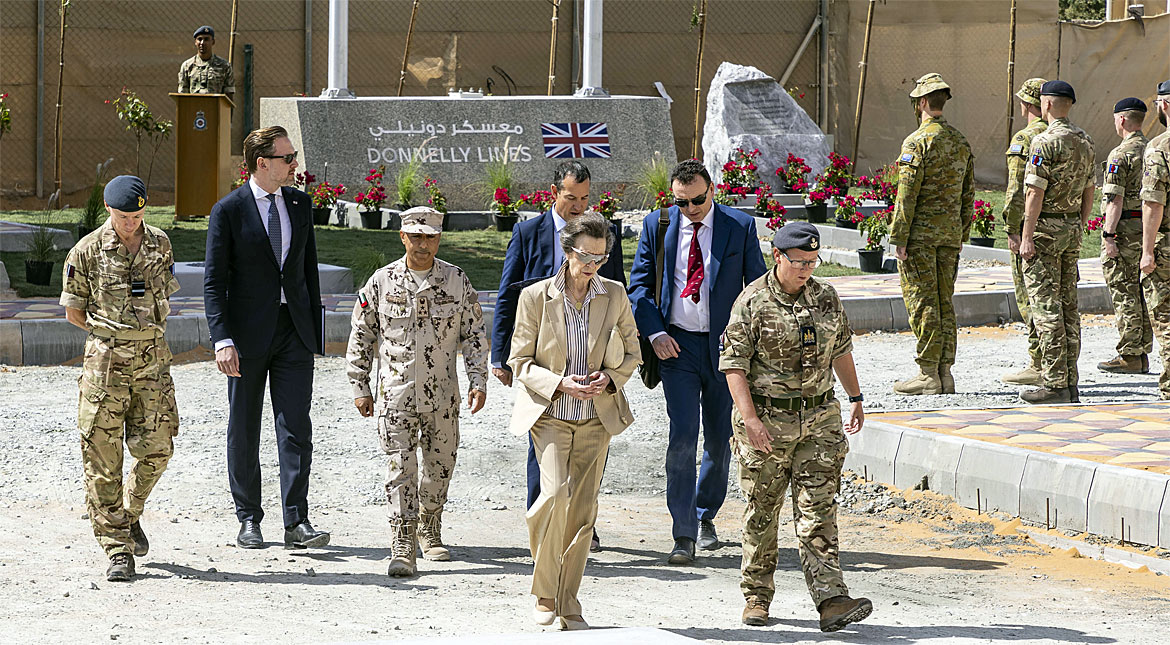
Her Royal Highness The Princess Royal has officially opened a permanent UK military facility on an air base in the United Arab Emirates (UAE).
The Princess Royal toured the brand-new Headquarters, accommodation and welfare facilities at Al Minhad Air Base (AMAB) alongside the Assistant Chief of the Defence Staff (Support Operations), Air Vice-Marshal Pratley. They were accompanied by Sir Hobart, His Majesty’s Ambassador to the UAE, and Brigadier General Al Ketbi, AMAB Commander.
Air Vice-Marshal Pratley said,“I am delighted to attend the opening of Donnelly Lines, an essential part of the UK’s global footprint, and an example of our enduring presence overseas in what remains an uncertain world beset by turbulent times. Our continued investment here is a further example of the UK’s commitment to the security of the region and is a tangible commitment to the work for peace, security, and stability, working hand in hand with our allies in the UAE. The siting of Donnelly Lines at AMAB enables the UK to maintain our freedom of action and ability to conduct operations from the UAE, bolstering our operational resilience. It is of vital importance, and I recognise the hard work and stellar efforts of the team, who have, over several years, worked tirelessly around the clock to make this possible.”
A joint UAE Air Force Al Fursan and RAF A400M flypast honoured the opening ceremony which included a coalition parade and a commemoration to the late Sergeant Donnelly, whom the Lines are named after.
The Princess Royal then met with Sergeant Donnelly’s family and coalition personnel based at AMAB where Her Royal Highness signed the legacy Joint Force Support flag that proudly flew over the base’s former UK Headquarters.
Donnelly Lines is named after Sergeant ‘Billy’ Donnelly, an RAF Navigator who died in February 1943 after his Vickers Wellington Bomber crash landed in Fujairah, 75 miles east of AMAB. In 2010, a memorial was erected at the crash site, and now in 2024, this expansive facility in his name symbolises the longstanding ties between the UK and the UAE and the continued commitment to strengthening that relationship.
raf.mod.uk
The Princess Royal toured the brand-new Headquarters, accommodation and welfare facilities at Al Minhad Air Base (AMAB) alongside the Assistant Chief of the Defence Staff (Support Operations), Air Vice-Marshal Pratley. They were accompanied by Sir Hobart, His Majesty’s Ambassador to the UAE, and Brigadier General Al Ketbi, AMAB Commander.
Air Vice-Marshal Pratley said,“I am delighted to attend the opening of Donnelly Lines, an essential part of the UK’s global footprint, and an example of our enduring presence overseas in what remains an uncertain world beset by turbulent times. Our continued investment here is a further example of the UK’s commitment to the security of the region and is a tangible commitment to the work for peace, security, and stability, working hand in hand with our allies in the UAE. The siting of Donnelly Lines at AMAB enables the UK to maintain our freedom of action and ability to conduct operations from the UAE, bolstering our operational resilience. It is of vital importance, and I recognise the hard work and stellar efforts of the team, who have, over several years, worked tirelessly around the clock to make this possible.”
A joint UAE Air Force Al Fursan and RAF A400M flypast honoured the opening ceremony which included a coalition parade and a commemoration to the late Sergeant Donnelly, whom the Lines are named after.
The Princess Royal then met with Sergeant Donnelly’s family and coalition personnel based at AMAB where Her Royal Highness signed the legacy Joint Force Support flag that proudly flew over the base’s former UK Headquarters.
Donnelly Lines is named after Sergeant ‘Billy’ Donnelly, an RAF Navigator who died in February 1943 after his Vickers Wellington Bomber crash landed in Fujairah, 75 miles east of AMAB. In 2010, a memorial was erected at the crash site, and now in 2024, this expansive facility in his name symbolises the longstanding ties between the UK and the UAE and the continued commitment to strengthening that relationship.
raf.mod.uk

UK launches first ever aid airdrop into Gaza with 10 tonnes of supplies
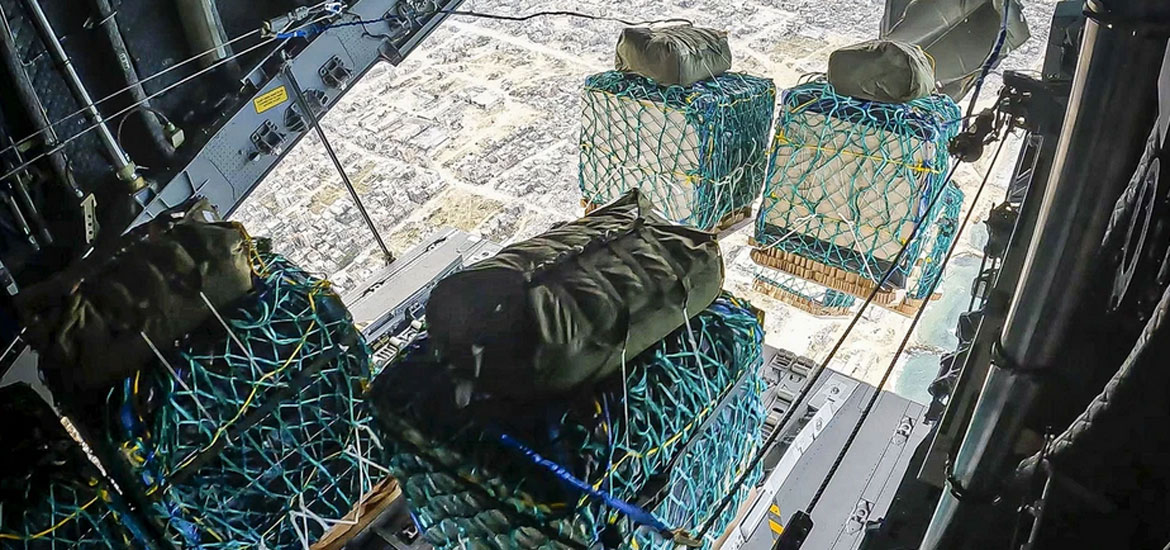
The UK has launched an airdrop of vital aid supplies into Gaza for the first time, as part of international efforts to provide life-saving assistance to civilians. More than 10 tonnes of food supplies were dropped by a Royal Air Force transport aircraft over the enclave on Monday. The aid, which included water, rice, cooking oil, flour, tinned goods and baby formula, was parachuted above a prearranged landing zone.
Defence Secretary Grant Shapps authorised the airdrop following what the Ministry of Defence said was an "assessed reduction in threat to the military mission and risk to civilians."
An RAF A400M Atlas transport plane flew from Amman, Jordan on the mission over the northern coastline of Gaza. The MoD said UK air force and army personnel worked closely with the Royal Jordanian Air Force to plan and conduct the mission.
Grant Shapps said: "The UK has already tripled our aid budget to Gaza, but we want to go further in order to reduce human suffering." Shapps added: "The hell that was unleashed by the October 7 Hamas attack has led to wide-scale innocent loss of life. The UK's goal is to use every route possible to deliver life-saving aid, whether that is by road, air or new routes via the sea. We also continue to call on Israel to provide port access and open more land crossings in order to increase incoming aid deliveries to Gaza."
The UK military describes the A400 Atlas as a "highly capable tactical and strategic airlift platform". Monday's airdrop was its first-ever mission delivering humanitarian aid by parachute. Military officials said the drop zones were surveyed before and during the airdrop to ensure aid was delivered directly to civilians.
The airdrop follows recent land deliveries of 2,000 tonnes of UK food aid to feed more than 275,000 people. Thousands of UK-funded blankets, tents and other relief items have also been sent to Gaza, alongside the establishment of a full UK-funded field hospital run by British charity UK-Med.
The UK Goverment said it would continue to work with allies, including Cyprus, the United States, European Union and United Arab Emirates, to open a direct maritime corridor to Gaza.
gbnews.com
[Footnote: An RAF A400M Atlas made a second airdrop of 10 tonnes of UK aid on Good Friday]
Defence Secretary Grant Shapps authorised the airdrop following what the Ministry of Defence said was an "assessed reduction in threat to the military mission and risk to civilians."
An RAF A400M Atlas transport plane flew from Amman, Jordan on the mission over the northern coastline of Gaza. The MoD said UK air force and army personnel worked closely with the Royal Jordanian Air Force to plan and conduct the mission.
Grant Shapps said: "The UK has already tripled our aid budget to Gaza, but we want to go further in order to reduce human suffering." Shapps added: "The hell that was unleashed by the October 7 Hamas attack has led to wide-scale innocent loss of life. The UK's goal is to use every route possible to deliver life-saving aid, whether that is by road, air or new routes via the sea. We also continue to call on Israel to provide port access and open more land crossings in order to increase incoming aid deliveries to Gaza."
The UK military describes the A400 Atlas as a "highly capable tactical and strategic airlift platform". Monday's airdrop was its first-ever mission delivering humanitarian aid by parachute. Military officials said the drop zones were surveyed before and during the airdrop to ensure aid was delivered directly to civilians.
The airdrop follows recent land deliveries of 2,000 tonnes of UK food aid to feed more than 275,000 people. Thousands of UK-funded blankets, tents and other relief items have also been sent to Gaza, alongside the establishment of a full UK-funded field hospital run by British charity UK-Med.
The UK Goverment said it would continue to work with allies, including Cyprus, the United States, European Union and United Arab Emirates, to open a direct maritime corridor to Gaza.
gbnews.com
[Footnote: An RAF A400M Atlas made a second airdrop of 10 tonnes of UK aid on Good Friday]

A new member who has joined us recently:
Welcome to the OBA!
Mark Hobson, Scarborough, N. Yorks

From: Syd Avery, Alicante
Subject: Flat Floor (19A)
Hi, Each and Every,
Harping back to the Falkland’s thread. When we arrived at ASC with Jim Stewart as boss, he took the day shift with his merry men, and I, with my band of happy troopers, had the night. arly hours, 0-dark-00. I went to check an Albert to make sure the aeroplane was ready movements wise for departure in a few hours time. Lo and behold, sitting in the freight bay, were two sergeants from the Hunter detachment. I asked who they were, (1250, please?) and what they were doing on the areoplane. they said “Going home.”
I said, "Why?" Their answer was, "We were told to by our squadron leader." I told them they were not going on that aeroplane; maybe, just maybe, on a later one when their ID’s and authorization had been checked.
After agreeing that my three stripes and one crown out-ranked their three stripes, we went to the office and phoned their squadron leader (much to their surprise!). I explained that as far as Movements were concerned, the two chappies had no authority to travel and could be doing a bunk. He completely agreed. Sent them back to him, and a couple of hours later same two chappies returned much chastised with written authority to leave, requesting travel as soon as possible. They did apologise and explained that their boss did not appreciate being woken up at 0-dark-15 in the morning.
Flat Floor Loads… Bait Shuttle: Bait Al Falaj-Salalah-Midway-Salalah-Masirah. Donkey fodder and tins of pilchards in tomato sauce / Gas cylinders, 436 lbs each if I remember correctly / Lightning Maxaret unit - very heavy!
Harrier detachment at Ouston. The last flight was to be a Mk.3, 19a+ winch Albert which went u/s. The replacement airframe was a 19a+ winch Mk.1! The original elastic aeroplane!
Don’t forget the joys of a re-role from flat floor to full pax. Had one 19a, to full pax then back to 19a. Oh the joys of being a flying stevadore. Do they do things like that these days?
Regards,
Syd
Subject: Flat Floor (19A)
Hi, Each and Every,
Harping back to the Falkland’s thread. When we arrived at ASC with Jim Stewart as boss, he took the day shift with his merry men, and I, with my band of happy troopers, had the night. arly hours, 0-dark-00. I went to check an Albert to make sure the aeroplane was ready movements wise for departure in a few hours time. Lo and behold, sitting in the freight bay, were two sergeants from the Hunter detachment. I asked who they were, (1250, please?) and what they were doing on the areoplane. they said “Going home.”
I said, "Why?" Their answer was, "We were told to by our squadron leader." I told them they were not going on that aeroplane; maybe, just maybe, on a later one when their ID’s and authorization had been checked.
After agreeing that my three stripes and one crown out-ranked their three stripes, we went to the office and phoned their squadron leader (much to their surprise!). I explained that as far as Movements were concerned, the two chappies had no authority to travel and could be doing a bunk. He completely agreed. Sent them back to him, and a couple of hours later same two chappies returned much chastised with written authority to leave, requesting travel as soon as possible. They did apologise and explained that their boss did not appreciate being woken up at 0-dark-15 in the morning.
Flat Floor Loads… Bait Shuttle: Bait Al Falaj-Salalah-Midway-Salalah-Masirah. Donkey fodder and tins of pilchards in tomato sauce / Gas cylinders, 436 lbs each if I remember correctly / Lightning Maxaret unit - very heavy!
Harrier detachment at Ouston. The last flight was to be a Mk.3, 19a+ winch Albert which went u/s. The replacement airframe was a 19a+ winch Mk.1! The original elastic aeroplane!
Don’t forget the joys of a re-role from flat floor to full pax. Had one 19a, to full pax then back to 19a. Oh the joys of being a flying stevadore. Do they do things like that these days?
Regards,
Syd


From: Ian Berry, Eastleaze, Swindon, Wilts
Subject: FLAT FLOOR LOADS
Hi Tony,
I did my Air Movements Course at the AMTS, RAF Abingdon in 1967. At that time the RAF Transport Fleet still numbered 280 aircraft but within the year we would say goodbye to the Hastings and Beverleys.
At this time aircraft pallets were still a novelty and the nets we used contained no hooks. If the item wasn't wheeled it was usually built in a stack from the floor upwards - heaviest on the bottom! We were then encouraged to make the chains into necklaces to encompass the stack. In reality, once away from the School this was a practice rarely achieved as the chains carried on the C130s, Argosies and Belfasts were limited and we would run out after restraining possibly only two fifths of the load. The answer as we knew was "up and overs". Usually a nightmare to do and always looked like a bag of nails! It's only in retrospect and looking backwards do I realise how flexible most of the AQM/ALMs had been.
The Op Dragonfly's were a good example. Quite often initiated on a Friday afternoon and then a mad dash by road to Lyneham to board the first of usually three Hercules to Marham and then Kinloss, taking our Landrover with us to Marham. The Marham MSF guys also worked wonders to produce the kit in an air-prepped state in the short time the activation was called. Hydraulic Rigs, Cylinder Trollies and much more crap appeared. Also lots of wooden boxes and rarely standardised. (As time wore on the RAF procured Lacon Containers). Being equipment to support the Victor Tankers there would also be several brake chutes in canvas bags, four handles and weighing 400lbs! Heaving these on top of "rickety" freight stacks often brought out the best words in the Anglo-Saxon language! Once finished loading, all this would be "nailed down" using "up and overs". As the last Herc would depart fro Kinloss we would head back to Abingdon by road. Usually calling into a fish and chip shop on the way and all looking as if we had just done a shift down a coal mine!
Slowly, over the years things did improve and I remember having to attend a presentation at the Movements School, Brize Norton, where a young looking Cpl Colin Allen gave us the lowdown on a new cargo net that could be used on palletised freight as well as flat floor loads. Things did improve but we all still in later life have developed back problems.
I concur with the comment from Tony that these days all PR pictures of the Movers show palletised loads or similar. I think they are just fortunate they have not encoutered an Op Bushell type of lift where literally thousands of tons of grain had to be flat floor loaded or air dropped.
Ian
Subject: FLAT FLOOR LOADS
Hi Tony,
I did my Air Movements Course at the AMTS, RAF Abingdon in 1967. At that time the RAF Transport Fleet still numbered 280 aircraft but within the year we would say goodbye to the Hastings and Beverleys.
At this time aircraft pallets were still a novelty and the nets we used contained no hooks. If the item wasn't wheeled it was usually built in a stack from the floor upwards - heaviest on the bottom! We were then encouraged to make the chains into necklaces to encompass the stack. In reality, once away from the School this was a practice rarely achieved as the chains carried on the C130s, Argosies and Belfasts were limited and we would run out after restraining possibly only two fifths of the load. The answer as we knew was "up and overs". Usually a nightmare to do and always looked like a bag of nails! It's only in retrospect and looking backwards do I realise how flexible most of the AQM/ALMs had been.
The Op Dragonfly's were a good example. Quite often initiated on a Friday afternoon and then a mad dash by road to Lyneham to board the first of usually three Hercules to Marham and then Kinloss, taking our Landrover with us to Marham. The Marham MSF guys also worked wonders to produce the kit in an air-prepped state in the short time the activation was called. Hydraulic Rigs, Cylinder Trollies and much more crap appeared. Also lots of wooden boxes and rarely standardised. (As time wore on the RAF procured Lacon Containers). Being equipment to support the Victor Tankers there would also be several brake chutes in canvas bags, four handles and weighing 400lbs! Heaving these on top of "rickety" freight stacks often brought out the best words in the Anglo-Saxon language! Once finished loading, all this would be "nailed down" using "up and overs". As the last Herc would depart fro Kinloss we would head back to Abingdon by road. Usually calling into a fish and chip shop on the way and all looking as if we had just done a shift down a coal mine!
Slowly, over the years things did improve and I remember having to attend a presentation at the Movements School, Brize Norton, where a young looking Cpl Colin Allen gave us the lowdown on a new cargo net that could be used on palletised freight as well as flat floor loads. Things did improve but we all still in later life have developed back problems.
I concur with the comment from Tony that these days all PR pictures of the Movers show palletised loads or similar. I think they are just fortunate they have not encoutered an Op Bushell type of lift where literally thousands of tons of grain had to be flat floor loaded or air dropped.
Ian

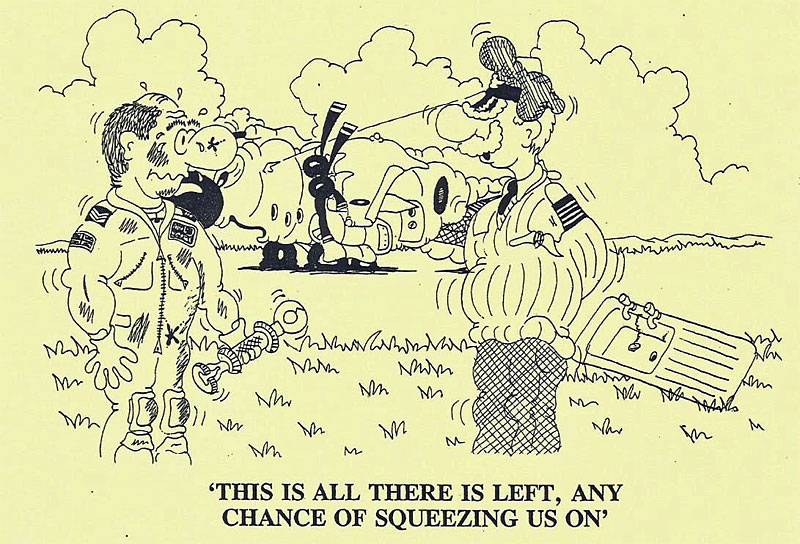

RAF Atlas aircrew and ground staff exchange skills with French
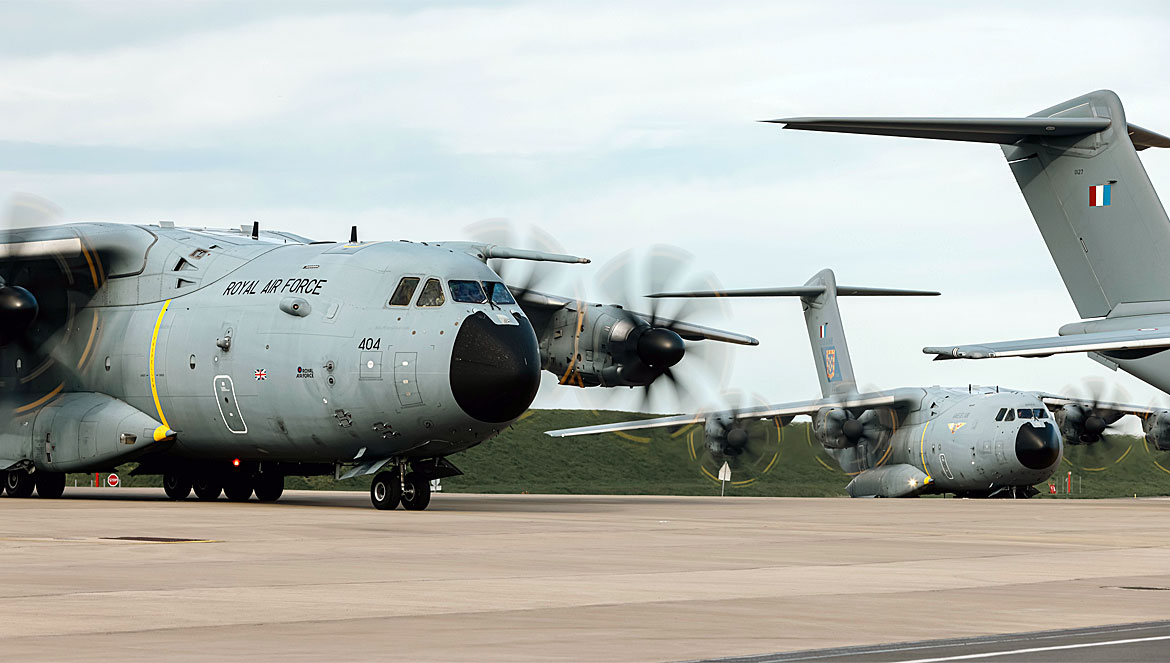
A Royal Air Force Atlas aircraft has flown to Orleans, France for its crew and ground support specialists to exchange expertise with the French Air and Space Force. Aircrew, engineers and specialists in air movements, fuel and airfield operations collaborated with their French counterparts at Bricy Air Base to test and improve their ability to work together and support each other in austere environments.
Detachment Commander, Squadron Leader Beard said, "The aim of the exercise is to train together as a coalition in a complex air environment, facing a high-level threat from a peer adversary. The French Air and Space Force have been superb and gracious hosts and the fact we both fly the A400M Atlas makes interoperability so much easier, we have both learnt a great deal from each other.”
The heavy lift aircraft, part of the Air Mobility Force based at RAF Brize Norton in Oxfordshire, showed its ability for Agile Combat Employment – to disperse from a targeted base at a moment’s notice, and operate in irregular or austere conditions with minimal support.
The team operated seamlessly from Bricy Air Base with support from local airfield services, showing the flexibility of the aircraft and the interoperability of the French and UK forces. Six other allied nations also took part including Spain, Canada, Greece and Italy, showing the RAF’s ability to collaborate with NATO and partner nations.
Project Officer, Flight Lieutenant Meredith said, “Each participating country is using this exercise to hone vital readiness skills and enhance interoperability between air forces. The RAF detachment made up of both regular and reserve forces have stepped up to the mark and delivered; proving again the agility of our air force and our ability to deploy and work from any location.”
raf.mod.uk
Detachment Commander, Squadron Leader Beard said, "The aim of the exercise is to train together as a coalition in a complex air environment, facing a high-level threat from a peer adversary. The French Air and Space Force have been superb and gracious hosts and the fact we both fly the A400M Atlas makes interoperability so much easier, we have both learnt a great deal from each other.”
The heavy lift aircraft, part of the Air Mobility Force based at RAF Brize Norton in Oxfordshire, showed its ability for Agile Combat Employment – to disperse from a targeted base at a moment’s notice, and operate in irregular or austere conditions with minimal support.
The team operated seamlessly from Bricy Air Base with support from local airfield services, showing the flexibility of the aircraft and the interoperability of the French and UK forces. Six other allied nations also took part including Spain, Canada, Greece and Italy, showing the RAF’s ability to collaborate with NATO and partner nations.
Project Officer, Flight Lieutenant Meredith said, “Each participating country is using this exercise to hone vital readiness skills and enhance interoperability between air forces. The RAF detachment made up of both regular and reserve forces have stepped up to the mark and delivered; proving again the agility of our air force and our ability to deploy and work from any location.”
raf.mod.uk

From: Colin Eyre, Bridgend, Glamorgan
Subject: Flat Floor Loads
Hi Tony,
Akrotiri 1966 - There had been a quite catastrophic earthquake in Turkey where, if I remember correctly, thousands had been killed.
When we came on duty for our night shift we were told that there were two 70 Sqn Hastings that had to be loaded with emergency relief supplies. These consisted, amongst other things, of tents and blankets. Those who remember the Hastings will know it was a bit of an uphill task. It took the best part of the night to get it done as it was all manhandled. Not sure who made the decision but it was then decided that only one aircraft would be going and so the loads had to changed. Here my faith in humanitarian aid was somewhat damaged when one of the loadmasters came into our office a few weeks later and he informed us that some of the blankets that had been sent were now for sale in a local market!
Rgds
Colin
Subject: Flat Floor Loads
Hi Tony,
Akrotiri 1966 - There had been a quite catastrophic earthquake in Turkey where, if I remember correctly, thousands had been killed.
When we came on duty for our night shift we were told that there were two 70 Sqn Hastings that had to be loaded with emergency relief supplies. These consisted, amongst other things, of tents and blankets. Those who remember the Hastings will know it was a bit of an uphill task. It took the best part of the night to get it done as it was all manhandled. Not sure who made the decision but it was then decided that only one aircraft would be going and so the loads had to changed. Here my faith in humanitarian aid was somewhat damaged when one of the loadmasters came into our office a few weeks later and he informed us that some of the blankets that had been sent were now for sale in a local market!
Rgds
Colin


From: Ian Place, Leeds, West Yorks
Subject: Flat Floor Loads
Subject: Flat Floor Loads

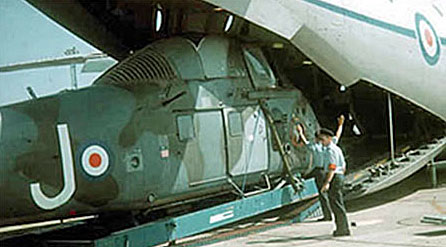
Tony,
I believe that 2 x Wessex helicopters on a Belfast was one of the worst flat floor loads ever. On the 7th February 1974 we flew XR368 Brize to Bardufoss in Norway arriving 12:10pm local and finished loading at 09:00am the following day. In 2024 these long hours would be illegal, but at the time we just shrugged our shoulders and carried on.
You remember that esteemed organisation JATE who used to plan loads for aircraft? It would seem when they sent out the plan they neglected to include all the additional equipment which went with the primary load...
Ian
I believe that 2 x Wessex helicopters on a Belfast was one of the worst flat floor loads ever. On the 7th February 1974 we flew XR368 Brize to Bardufoss in Norway arriving 12:10pm local and finished loading at 09:00am the following day. In 2024 these long hours would be illegal, but at the time we just shrugged our shoulders and carried on.
You remember that esteemed organisation JATE who used to plan loads for aircraft? It would seem when they sent out the plan they neglected to include all the additional equipment which went with the primary load...
Ian

From: Paul Thornton, Blyth, Northumberland
Subject: Flat Floor Loads
Hi Tony
On the subject of 'flat floor' loads, there is only one truly pain in the backside load and that was the Mk 11 Hydraulic Rig. 2 tracks of dunnage from the toe ramps, then jack it up to put the 4 blocks of wood to bring the solid wheels off the floor, 4 safety chains, the double nets. A Tornado move from Goose Bay to Alaska/Vegas involved a lot of Mk 11's. We even put them on linked pallets to fit into KC1. A right pain.
All the best
Paul
Subject: Flat Floor Loads
Hi Tony
On the subject of 'flat floor' loads, there is only one truly pain in the backside load and that was the Mk 11 Hydraulic Rig. 2 tracks of dunnage from the toe ramps, then jack it up to put the 4 blocks of wood to bring the solid wheels off the floor, 4 safety chains, the double nets. A Tornado move from Goose Bay to Alaska/Vegas involved a lot of Mk 11's. We even put them on linked pallets to fit into KC1. A right pain.
All the best
Paul


From: Dougie Russell, Carlilse
Subject: Flat Floor Loads
Hi Tony,
Over my 24-year RAF career, I handled various aircraft with flat floor loads and one good one springs to mind. When I was based at Wyton with Barney Fielder in 1982-1985, we had the joy of looking after the Norway re-supply C130 (Phantom/Lightning parachutes and wheels etc.). We had between 10-15 airports of call from South to North with 2 night stops thrown in. This trip included a 25-foot bomb trolley coming back to the UK to be scrapped. Not such a great idea as it was in the middle of the route on our way North. Rather than picking it up when we were southbound, we decided to load it on the way up to Bardufoss and re-shuffled the load for the southbound legs carrying all the kit past said bomb trolly. Happy Days!
Regards,
Dougie
Former SGT RAF / MSF / JHSU(G) / UKMAMS / EUROMAMS
All-round good egg and snappy dresser!
Subject: Flat Floor Loads
Hi Tony,
Over my 24-year RAF career, I handled various aircraft with flat floor loads and one good one springs to mind. When I was based at Wyton with Barney Fielder in 1982-1985, we had the joy of looking after the Norway re-supply C130 (Phantom/Lightning parachutes and wheels etc.). We had between 10-15 airports of call from South to North with 2 night stops thrown in. This trip included a 25-foot bomb trolley coming back to the UK to be scrapped. Not such a great idea as it was in the middle of the route on our way North. Rather than picking it up when we were southbound, we decided to load it on the way up to Bardufoss and re-shuffled the load for the southbound legs carrying all the kit past said bomb trolly. Happy Days!
Regards,
Dougie
Former SGT RAF / MSF / JHSU(G) / UKMAMS / EUROMAMS
All-round good egg and snappy dresser!


The Royal Canadian Air Force is Celebrating 100 Years!
Town and city halls across Canada will be illuminated with blue on April 1st to celebrate 100 years


From: Dave Neylan, Amberly, QLD
Subject: Movements Mafia Reunion
Hi Tony,
Subject: Movements Mafia Reunion
Hi Tony,
MOVEMENTS MAFIA REUNION 22 JUNE 2024

I’ve have booked a marquee with the Ipswich Turf Club for the Movements reunion on the 22nd of June 2024. The cost is $195 per person and will include:
•Entry to the track
•Private Marquee with trackside frontage overlooking the home straight on the grandstand side of the track.
•Beverage package including beer, wine, pre-mixed spirits and soft drinks from 11am until the last race
•3 Hour premium finger food package
•Access to the after party and live band
If you would like to secure a spot please complete the following before the 15th of April 2024:
* Transfer $195 per ticket to the following bank account details;
Bank: Australian Military Bank
Account Name: D A Neylan
BSB: 642 170
Account #: 100012064
Reference: Your Name
* Once you have made your payment please email your payment details and phone number to;
movements.mafia@hotmail.com
I will track all payments and confirm by return email that you are good to go.
Looking forward to catching up with you all and please reach out if you have any issues or concerns.
Cheers
Dave Neylan
•Entry to the track
•Private Marquee with trackside frontage overlooking the home straight on the grandstand side of the track.
•Beverage package including beer, wine, pre-mixed spirits and soft drinks from 11am until the last race
•3 Hour premium finger food package
•Access to the after party and live band
If you would like to secure a spot please complete the following before the 15th of April 2024:
* Transfer $195 per ticket to the following bank account details;
Bank: Australian Military Bank
Account Name: D A Neylan
BSB: 642 170
Account #: 100012064
Reference: Your Name
* Once you have made your payment please email your payment details and phone number to;
movements.mafia@hotmail.com
I will track all payments and confirm by return email that you are good to go.
Looking forward to catching up with you all and please reach out if you have any issues or concerns.
Cheers
Dave Neylan
Tony Gale
ukmamsoba@gmail.com
ukmamsoba@gmail.com
This Newsletter is Dedicated
to the Memories of:
Eric Porte (RCAF)
Pete Cowan (RAF)
Bernie LaFrance (RCAF)
"Troop" John Smith (RAF)
Marie-Pier Lapointe (RCAF)
John Walter Chambers (RAF)
Gary Portas (RNZAF - 060123)
to the Memories of:
Eric Porte (RCAF)
Pete Cowan (RAF)
Bernie LaFrance (RCAF)
"Troop" John Smith (RAF)
Marie-Pier Lapointe (RCAF)
John Walter Chambers (RAF)
Gary Portas (RNZAF - 060123)








